 | –≠–ª–µ–∫—Ç—Ä–æ–Ω–Ω—ã–π –∫–æ–º–ø–æ–Ω–µ–Ω—Ç: SAA7201 | –°–∫–∞—á–∞—Ç—å:  PDF PDF  ZIP ZIP |
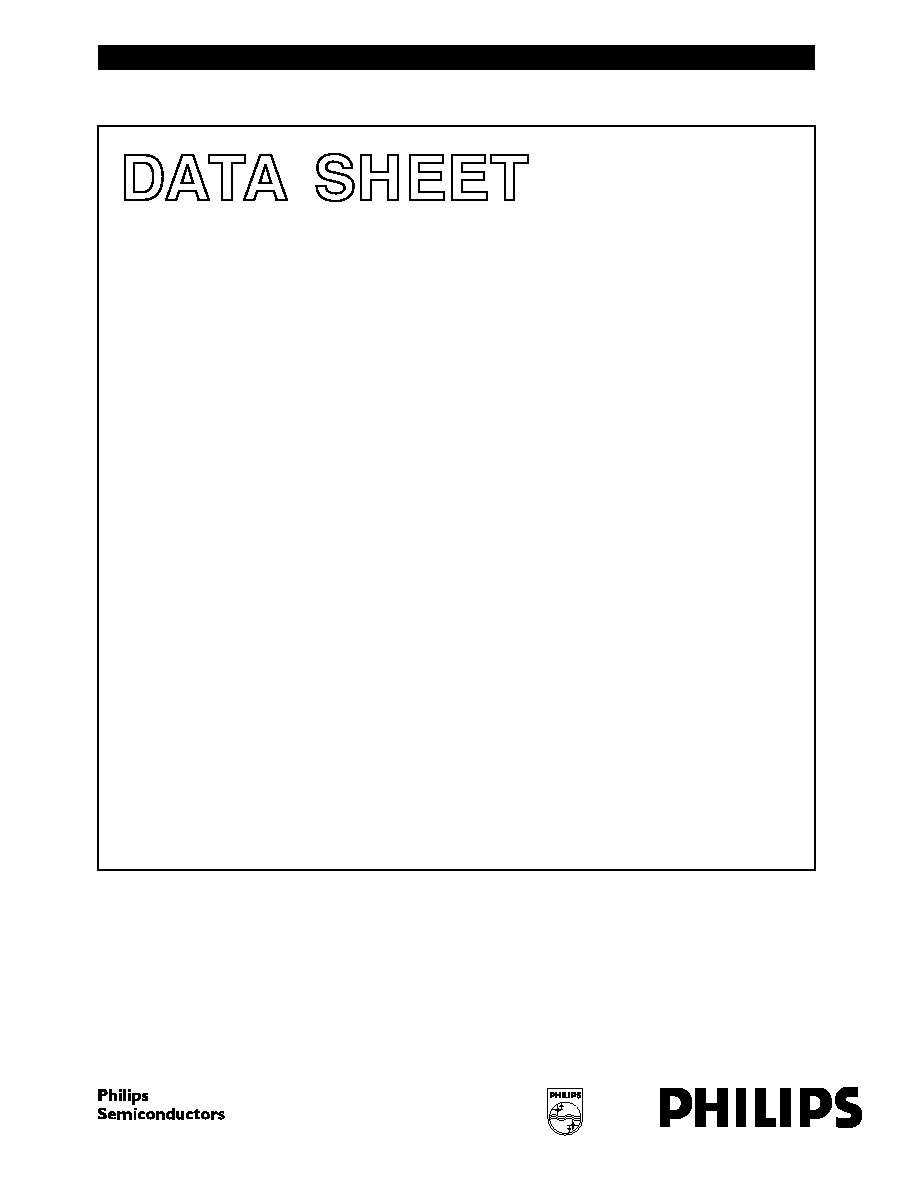
DATA SHEET
Objective specification
File under Integrated Circuits, IC02
1997 Jan 29
INTEGRATED CIRCUITS
SAA7201
Integrated MPEG2 AVG decoder

1997 Jan 29
2
Philips Semiconductors
Objective specification
Integrated MPEG2 AVG decoder
SAA7201
FEATURES
General
∑
Uses single external Synchronous DRAM (SDRAM)
organized as 1M
◊
16 interfacing at 81 MHz; compatible
with the SDRAM `lite' or `PC'
∑
Fast external CPU interface; 16-bit data + 8-bit address
∑
Dedicated input for audio and video data in PES or ES
format; data input rate:
9 Mbytes/s in byte mode;
20 Mbit/s in bit serial mode; audio and/or video data
can also serve as input via CPU interface
∑
Single 27 MHz external clock for time base reference
and internal processing; all required decoding and
presentation clocks are generated internally
∑
Internal system time base at 90 kHz can be
synchronized via CPU port
∑
Flexible memory allocation under control of the external
CPU enables optimized partitioning of memory for
different tasks
∑
Boundary scan (JTAG) plus external SDRAM self test
implemented
∑
Supply voltage 3.3 V
∑
Package 160 QFP.
CPU relation
∑
16-bit data, 8-bit address, or 16-bit multiplexed bus;
Motorola and Intel mode supported
∑
Support for fast DMA transfer to either internal registers
or external SDRAM
∑
Maximum sustained rate to the external SDRAM is
9 Mbytes/s.
MPEG2 system
∑
Parsing of MPEG2 PES and MPEG1 packet streams
∑
Double System Time Clock (STC) counters for
discontinuity handling
∑
Time stamps or CPU controlled audio/video
synchronization
∑
Support for seamless time base change (edition)
∑
Processing of errors flagged by channel decoding or
demux section
∑
Support for retrieval of PES header and PES private
data.
MPEG2 audio
∑
Decoding of 2 channel, layer I and II MPEG audio;
support for mono, stereo, intensity stereo and dual
channel mode
∑
Constant and variable bit rates up to 448 kbit/s
∑
Audio sampling frequencies: 48, 44.1, 32, 24, 22.05 and
16 kHz
∑
CRC error detection
∑
Selectable output channel in dual channel mode
∑
Independent volume control for both channels and
programmable inter-channel crosstalk control through a
baseband audio processing unit
∑
Storage ancillary data up to 54 bytes
∑
Dynamic range control at output
∑
Muting possibility via external controller; automatic
muting in case of errors
∑
Generation of `beeps' with programmable tone height,
duration and amplitude
∑
Serial two channel digital audio output with 16, 18, 20 or
22 bits per sample, compatible with either I
2
S or
Japanese formats
∑
Serial SPDIF audio output
∑
Clock output 256 or 384
◊
f
s
for external D/A converter
∑
Audio input buffer in external SDRAM with
programmable size (default is 64 kbit)
∑
Programmable processing delay compensation
∑
Software controlled stop, pause, restricted skip, and
restart functions.
MPEG2 video
∑
Decoding of MPEG2 video up to main level, main profile
∑
Nominal video input buffer size equals 2.6 Mbit for Video
Main Profile and Main Level (MP@ML)
∑
Output picture format: CCIR-601 4 : 2 : 2 interlaced
pictures; picture format 720
◊
576 at 50 Hz or 720
◊
480
at 60 Hz
∑
3 : 2 pull-down supported with 24 and 30 Hz sequences
∑
Support of constant and variable bit rates up to 15 Mbit/s
∑
Output interface at 8-bit wide, 27 MHz UYVY
multiplexed bus
∑
Horizontal and vertical pan and scan allows the
extraction of a window from the coded picture

1997 Jan 29
3
Philips Semiconductors
Objective specification
Integrated MPEG2 AVG decoder
SAA7201
∑
Flexible horizontal continuous scaling from 0.5 up to 4
allows easy aspect ratio conversion including support
for 2.21 : 1 aspect ratio movies
∑
Vertical scaling with fixed factors 0.5, 1 or 2 to support
picture scaling and up-sampling
∑
Scaling of incoming pictures to 25% of their original size
with anti-aliasing filtering to free screen space for
graphics applications like electronic program guides
∑
Non-full screen MPEG pictures will be displayed in a box
of which position and background colour are adjustable
by the external CPU
∑
Video output may be slaved to internally (master)
generated or externally (slave) supplied HV
synchronization signals; the position of active video is
programmable; MPEG timebase changes do not
affected the display phase
∑
Video output direct connectable to SAA718X encoder
family
∑
Various trick modes under control of external CPU:
≠ Freeze I or P pictures; restart on I picture
≠ Freeze on B pictures; restart at any moment
≠ Scanning and decoding of I or I and P pictures
≠ Single step mode
≠ Repeat/Skip field for time base correction.
Graphics
∑
Graphics is region based and presented in boxes
independent of video format
∑
Screen arrangement of boxes is determined by display
list mechanism which allows for multiple boxes,
background loading, fast switching, scrolling and fading
of regions
∑
Support of 2, 4, 8 bits/pixel bit-maps in fixed bit-maps or
coded in accordance to the DVB variable/run length
standard for region bases graphics
∑
Optimized memory control in MPEG video decoding
allows for storage of graphical bit-maps up to 1.2 Mbit in
50 Hz and 2.0 Mbit in 60 Hz systems
∑
VL/RL encoding enables full screen graphics at
8 bit/pixel in 50 Hz
∑
Fast CPU access enables full bit-map updates within a
display field period
∑
Display colours are obtained via colour look-up tables;
CLUT output is YUVT at 8-bit for each signal component
thus enabling 16M different colours and 6-bit for T
(transparency) which gives 64 mixing levels with video
∑
Bit-map table mechanism to specify a sub-set of entries
if the CLUT is larger than required by the coded bit
pattern; supported bit-map tables are 16 to 256,
4 to 256 and 4 to 16
∑
Graphics boxes may not overlap vertically; if 256 entry
CLUT has to be down loaded, a vertical separation of
1 field line is mandatory
∑
Internal support for fast block moves in the external
SDRAM during MPEG decoding
∑
Graphics mechanism can be used for signal generation
in the vertical blanking interval; useful for teletext, wide
screen signalling, closed caption etc.
∑
Support for a single down-loadable cursor of 1 kpixel
with programmable shape; supported shapes are
8
◊
128, 16
◊
64, 32
◊
32, 64
◊
16 and 128
◊
8
∑
Cursor colours are determined via a 4-entry CLUT with
YUVT at 6, 4, 4 respectively 2 bits; mixing of cursor with
video + graphics in 4 levels
∑
Cursor can be moved freely across the screen without
overlapping restrictions.

1997 Jan 29
4
Philips Semiconductors
Objective specification
Integrated MPEG2 AVG decoder
SAA7201
GENERAL DESCRIPTION
The SAA7201 is an MPEG2 decoder which combines
audio decoding and video decoding. Additionally to these
basic MPEG functions it also provides means for
enhanced graphics and/or on-screen display.
Due to an optimized architecture for audio and video
decoding, maximum capacity in the external memory and
processing power from the external CPU is available for
the support for graphics.
QUICK REFERENCE DATA
ORDERING INFORMATION
SYMBOL
PARAMETER
MIN.
TYP.
MAX.
UNIT
V
DD
functional supply voltage
3.0
3.3
3.6
V
V
CC
pad supply voltage
3.0
3.3
3.6
V
I
DD(tot)
total supply current at V
DD
= 3.3 V
-
tbf
-
mA
f
CLK
clock frequency
-
27.0
-
MHz
f
CLK
frequency deviation
-
30
◊
10
-
6
-
+30
◊
10
-
6
TYPE
NUMBER
PACKAGE
NAME
DESCRIPTION
VERSION
SAA7201H
QFP160
plastic quad flat package; 160 leads (lead length 1.95 mm);
body 28
◊
28
◊
3.4 mm; high stand-off height
SOT322-4

1997 Jan 29
5
Philips Semiconductors
Objective specification
Integrated MPEG2 AVG decoder
SAA7201
BLOCK DIAGRAM
Fig.1 Block diagram.
handbook, full pagewidth
AUDIO/VIDEO
INTERFACE
HOST
INTERFACE
SYSTEM TIME
BASE UNIT
VIDEO INPUT
BUFFER & SYNC
MEMORY
INTERFACE
VIDEO
DECODER
GRAPHICS
UNIT
AUDIO INPUT
BUFFER & SYNC
CLOCK
GENERATION
JTAG
MGD322
159
A_STROBE
77
75
74
78
84
83
81
80
SDRAM_RAS
VDDCO1 to
VDDCO4
SDRAM_WE
CP81M
READO
READI
SDRAM_ADDR
(11 to 0)
SDRAM_DATA
(15 to 0)
SDRAM_CAS
SDRAM_UDQ
CP81MEXT
CPU_TYPE
DMA_REQ
DMA_ACK
DMA_RDY
DMA_DONE
V_STROBE
ERROR
MUX
HS
VS
106
107
CS
DS
AS
R/W
DTACK
ADDRESS(8 to 1)
DATA(15 to 0)
IRQ(3 to 0)
AV_DATA(0 to 7)
2
1
8
CLK
124
RESET
138
9
10
4
4
3
6
5
DISPLAY
UNIT
SD
SCLK
WS
SPDIF
143
142
145
146
AUDIO
DECODER
GRPH
YUV(7 to 0)
119
FSCLK
139
11
12
8
148
147
8
16
8
16
12
4
SAA7201
VSSCO1 to VSSCO4
4
VSS1 to VSS16
16
VSSA
122
VDD1 to
VDD16
16
VDDA
121

1997 Jan 29
6
Philips Semiconductors
Objective specification
Integrated MPEG2 AVG decoder
SAA7201
PINNING
SYMBOL
PIN
DESCRIPTION
V
I/O
MUX
1
multiplexed/non-multiplexed (active LOW) bus input
5.0
I
CPU_TYPE
2
Intel/Motorola (active LOW) selection input
5.0
I
DMA_ACK
3
DMA acknowledge input
3.3
I
DMA_REQ
4
DMA request input and output
3.3
I/O
DMA_DONE
5
DMA end input
3.3
I
DMA_RDY
6
DMA ready output
3.3
O/Z
V
SS1
7
ground for pad ring
3.3
-
CS
8
chip select input
5.0
I
DS
9
data strobe input
5.0
I
AS
10
address strobe input
5.0
I
R/W
11
read/write (active LOW) input
5.0
I
DTACK
12
data acknowledge output
5.0
O/Z
V
DD1
13
supply for pad ring
3.3
-
IRQ0
14
individually maskable interrupts
3.3
O/Z
IRQ1
15
individually maskable interrupts
3.3
O/Z
IRQ2
16
individually maskable interrupts
3.3
O/Z
IRQ3
17
individually maskable interrupts
3.3
O/Z
V
SS2
18
ground for pad ring
-
-
V
SSCO1
19
ground for core logic
-
-
V
DDCO1
20
supply for core logic
3.3
-
DATA0
21
CPU data interface
5.0
I/O
DATA1
22
CPU data interface
5.0
I/O
DATA2
23
CPU data interface
5.0
I/O
DATA3
24
CPU data interface
5.0
I/O
V
DD2
25
supply for pad ring
3.3
-
DATA4
26
CPU data interface
5.0
I/O
DATA5
27
CPU data interface
5.0
I/O
DATA6
28
CPU data interface
5.0
I/O
DATA7
29
CPU data interface
5.0
I/O
V
SS3
30
ground for pad ring
-
-
DATA8
31
CPU data interface
5.0
I/O
DATA9
32
CPU data interface
5.0
I/O
DATA10
33
CPU data interface
5.0
I/O
DATA11
34
CPU data interface
5.0
I/O
V
DD3
35
supply for pad ring
-
-
DATA12
36
CPU data interface
5.0
I/O
DATA13
37
CPU data interface
5.0
I/O
DATA14
38
CPU data interface
5.0
I/O
DATA15
39
CPU data interface
5.0
I/O
V
SS4
40
ground for pad ring
-
-

1997 Jan 29
7
Philips Semiconductors
Objective specification
Integrated MPEG2 AVG decoder
SAA7201
ADDRESS1
41
CPU address interface
5.0
I
ADDRESS2
42
CPU address interface
5.0
I
ADDRESS3
43
CPU address interface
5.0
I
ADDRESS4
44
CPU address interface
5.0
I
V
DD4
45
supply for pad ring
3.3
-
ADDRESS5
46
CPU address interface
5.0
I
ADDRESS6
47
CPU address interface
5.0
I
ADDRESS7
48
CPU address interface
5.0
I
ADDRESS8
49
CPU address interface
5.0
I
V
SS5
50
ground for pad ring
-
-
V
SSCO2
51
ground for core logic
-
-
V
DDCO2
52
supply for core logic
3.3
-
SDRAM_DATA0
53
memory data interface
3.3
I/O
SDRAM_DATA15
54
memory data interface
3.3
I/O
SDRAM_DATA1
55
memory data interface
3.3
I/O
V
DD5
56
supply for pad ring
3.3
-
SDRAM_DATA14
57
memory data interface
3.3
I/O
SDRAM_DATA2
58
memory data interface
3.3
I/O
SDRAM_DATA13
59
memory data interface
3.3
I/O
V
SS6
60
ground for pad ring
-
-
SDRAM_DATA3
61
memory data interface
3.3
I/O
SDRAM_DATA12
62
memory data interface
3.3
I/O
SDRAM_DATA4
63
memory data interface
3.3
I/O
V
DD6
64
supply for pad ring
3.3
-
SDRAM_DATA11
65
memory data interface
3.3
I/O
SDRAM_DATA5
66
memory data interface
3.3
I/O
SDRAM_DATA10
67
memory data interface
3.3
I/O
V
SS7
68
ground for pad ring
-
-
SDRAM_DATA6
69
memory data interface
3.3
I/O
SDRAM_DATA9
70
memory data interface
3.3
I/O
SDRAM_DATA7
71
memory data interface
3.3
I/O
V
DD7
72
supply for pad ring
3.3
-
SDRAM_DATA8
73
memory data interface
3.3
I/O
SDRAM_WE
74
SDRAM write enable output
3.3
O
SDRAM_CAS
75
SDRAM column address strobe output
3.3
O
V
SS8
76
ground for pad ring
-
-
SDRAM_RAS
77
SDRAM row address strobe output
3.3
O
SDRAM_UDQ
78
SDRAM write mask output
3.3
O
V
DD8
79
supply for pad ring
3.3
-
READ
I
80
read command input
3.3
I
SYMBOL
PIN
DESCRIPTION
V
I/O

1997 Jan 29
8
Philips Semiconductors
Objective specification
Integrated MPEG2 AVG decoder
SAA7201
READ
O
81
read command output
3.3
O
V
SS9
82
ground for pad ring
-
-
CP81MEXT
83
81 MHz clock return path input
3.3
I
CP81M
84
81 MHz memory clock output
3.3
O
V
DD9
85
supply for pad ring
3.3
-
SDRAM_ADDR8
86
memory address
3.3
O
SDRAM_ADDR9
87
memory address
3.3
O
SDRAM_ADDR11
88
memory address
3.3
O
V
SS10
89
ground for pad ring
-
-
SDRAM_ADDR7
90
memory address
3.3
O
SDRAM_ADDR10 91
memory address
3.3
O
SDRAM_ADDR6
92
memory address
3.3
O
V
DD10
93
supply for pad ring
3.3
-
SDRAM_ADDR0
94
memory address
3.3
O
SDRAM_ADDR5
95
memory address
3.3
O
SDRAM_ADDR1
96
memory address
3.3
O
V
SS11
97
ground for pad ring
-
-
SDRAM_ADDR4
98
memory address
3.3
O
SDRAM_ADDR2
99
memory address
3.3
O
SDRAM_ADDR3
100
memory address
3.3
O
V
SSCO3
101
ground for core logic
-
-
V
DDCO3
102
supply for core logic
3.3
-
V
DD11
103
supply for pad ring
3.3
-
TEST8
104
IC test interface
3.3
I/O
TEST7
105
IC test interface
3.3
I/O
HS
106
horizontal synchronization input and output
3.3
I/O
VS
107
vertical synchronization input and output
3.3
I/O
V
SS12
108
ground for pad ring
-
-
YUV0
109
YUV video output at 27 MHz
3.3
O/Z
YUV1
110
YUV video output at 27 MHz
3.3
O/Z
YUV2
111
YUV video output at 27 MHz
3.3
O/Z
YUV3
112
YUV video output at 27 MHz
3.3
O/Z
V
DD12
113
supply for pad ring
3.3
-
YUV4
114
YUV video output at 27 MHz
3.3
O/Z
YUV5
115
YUV video output at 27 MHz
3.3
O/Z
YUV6
116
YUV video output at 27 MHz
3.3
O/Z
YUV7
117
YUV video output at 27 MHz
3.3
O/Z
TEST6
118
IC test interface
3.3
I/O
GRPH
119
indicator for graphics information output
3.3
O
TEST5
120
IC test interface
3.3
I/O
SYMBOL
PIN
DESCRIPTION
V
I/O

1997 Jan 29
9
Philips Semiconductors
Objective specification
Integrated MPEG2 AVG decoder
SAA7201
V
DDA
121
supply for analogue blocks
3.3
-
V
SSA
122
ground for analogue blocks
-
-
V
SS13
123
ground for pad ring
-
-
CLK
124
27 MHz clock input
3.3
I
V
SS14
125
ground for pad ring
-
-
TCLK
126
boundary scan test clock input
3.3
I
TRST
127
boundary scan test reset input
3.3
I
TMS
128
boundary scan test mode select input
3.3
I
TD
O
129
boundary scan test data output
3.3
O
TD
I
130
boundary scan test data input
3.3
I
V
DD13
131
supply for pad ring
3.3
-
TEST4
132
IC test interface
3.3
I/O
TEST3
133
IC test interface
3.3
I/O
TEST2
134
IC test interface
3.3
I/O
TEST1
135
IC test interface
3.3
I/O
TEST0
136
IC test interface
3.3
I/O
V
DD14
137
supply for pad ring
3.3
-
RESET
138
hard reset input (active LOW)
3.3
I
FSCLK
139
256 or 384 f
s
(audio sampling) output
3.3
O/Z
V
DDCO4
140
supply for core logic
3.3
-
V
SSCO4
141
ground for core logic
-
-
SCLK
142
serial audio clock output
3.3
O/Z
SD
143
serial audio data output
3.3
O/Z
V
SS15
144
ground for pad ring
-
-
WS
145
word select output
3.3
O/Z
SPDIF
146
digital audio output
3.3
O/Z
ERROR
147
flag for bitstream error input
5.0
I
V_STROBE
148
video strobe input
5.0
I
V
DD15
149
supply for pad ring
3.3
-
AV_DATA0
150
MPEG input port for PES data
5.0
I
AV_DATA1
151
MPEG input port for PES data
5.0
I
AV_DATA2
152
MPEG input port for PES data
5.0
I
AV_DATA3
153
MPEG input port for PES data
5.0
I
V
SS16
154
ground for pad ring
-
-
AV_DATA4
155
MPEG input port for PES data
5.0
I
AV_DATA5
156
MPEG input port for PES data
5.0
I
AV_DATA6
157
MPEG input port for PES data
5.0
I
AV_DATA7
158
MPEG input port for PES data
5.0
I
A_STROBE
159
audio strobe input
5.0
I
V
DD16
160
supply for pad ring
3.3
-
SYMBOL
PIN
DESCRIPTION
V
I/O
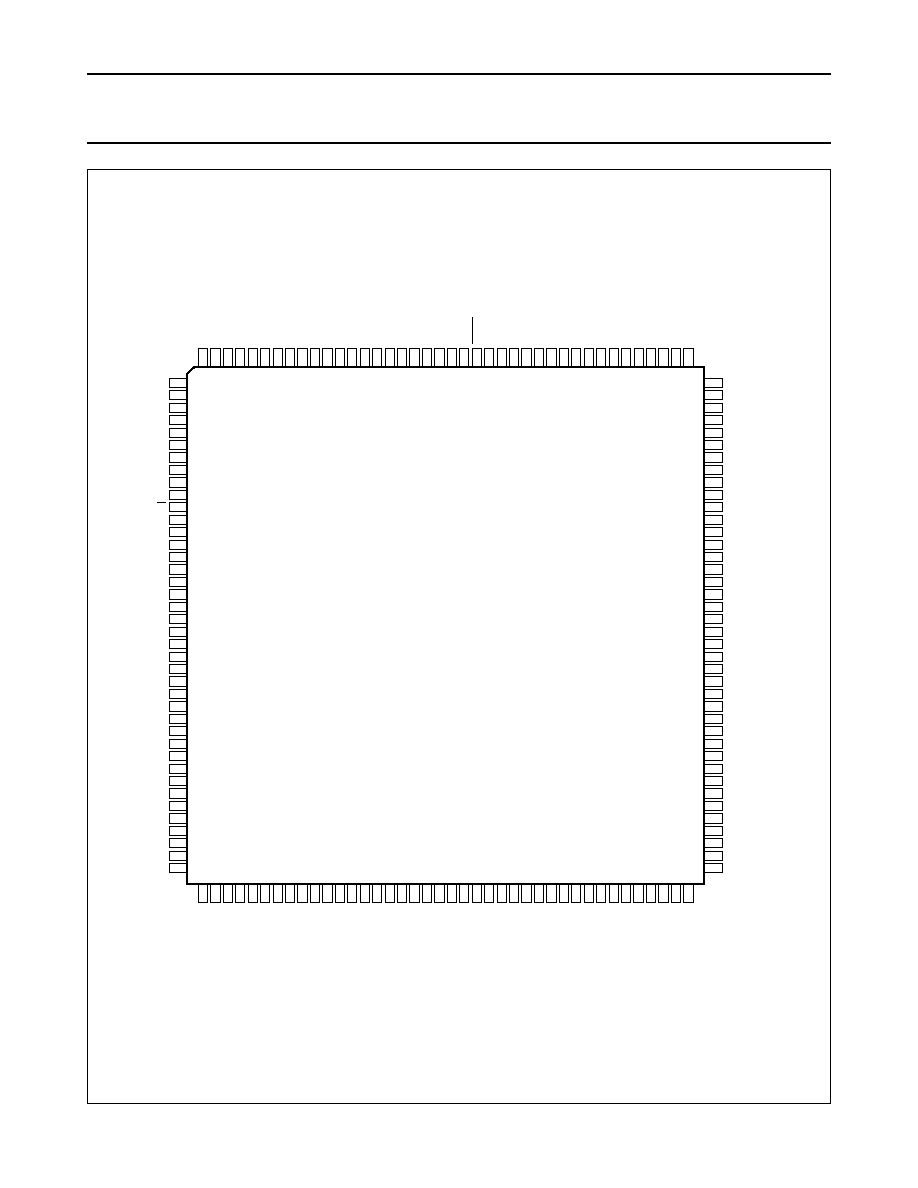
1997 Jan 29
10
Philips Semiconductors
Objective specification
Integrated MPEG2 AVG decoder
SAA7201
Fig.2 Pin configuration.
handbook, full pagewidth
MGD321
SAA7201
1
2
3
4
5
6
7
8
9
10
11
12
13
14
15
16
17
18
19
20
21
22
23
24
25
26
27
28
29
30
31
32
33
34
35
36
37
38
39
40
MUX
CPU_TYPE
DMA_ACK
DMA_REQ
DMA_DONE
DMA_RDY
VSS1
CS
DS
AS
R/W
DTACK
VDD1
IRQ0
IRQ1
IRQ2
IRQ3
VSS2
VSSCO1
VDDCO1
DATA0
DATA1
DATA2
DATA3
VDD2
DATA4
DATA5
DATA6
DATA7
VSS3
DATA8
DATA9
DATA10
DATA11
VDD3
DATA12
DATA13
DATA14
DATA15
VSS4
120
119
118
117
116
115
114
113
112
111
110
109
108
107
106
105
104
103
102
101
100
99
98
97
96
95
94
93
92
91
90
89
88
87
86
85
84
83
82
81
160
159
158
157
156
155
154
153
152
151
150
149
148
147
146
145
144
143
142
141
140
139
138
137
136
135
134
133
132
131
130
129
128
127
126
125
124
123
122
121
41
42
43
44
45
46
47
48
49
50
51
52
53
54
55
56
57
58
59
60
61
62
63
64
65
66
67
68
69
70
71
72
73
74
75
76
77
78
79
80
TEST5
GRPH
TEST6
YUV7
YUV6
YUV5
YUV4
VDD12
YUV3
YUV2
YUV1
YUV0
VSS12
VS
HS
TEST7
TEST8
VDD11
VDDCO3
VSSCO3
SDRAM_ADDR3
SDRAM_ADDR2
SDRAM_ADDR4
VSS11
SDRAM_ADDR1
SDRAM_ADDR5
SDRAM_ADDR0
VDD10
SDRAM_ADDR6
SDRAM_ADDR10
SDRAM_ADDR7
VSS10
SDRAM_ADDR11
SDRAM_ADDR9
SDRAM_ADDR8
VDD9
CP81M
CP81MEXT
VSS9
READO
V
DD16
A_STROBE
AV_DATA7
AV_DATA6
AV_DATA5
AV_DATA4
V
SS16
AV_DATA3
AV_DATA2
AV_DATA1
AV_DATA0
V
DD15
V_STROBE
ERROR
SPDIF
WS
V
SS15
SD
SCLK
V
SSCO4
V
DDCO4
FSCLK
RESET
V
DD14
TEST0
TEST1
TEST2
TEST3
TEST4
V
DD13
TD
I
TD
O
TMS
TRST
TCLK
V
SS14
CLK
V
SS13
V
SSA
V
DDA
ADDRESS1
ADDRESS2
ADDRESS3
ADDRESS4
V
DD4
ADDRESS5
ADDRESS6
ADDRESS7
ADDRESS8
V
SS5
V
SSCO2
V
DDCO2
SDRAM_DATA0
SDRAM_DATA15
SDRAM_DATA1
V
DD5
SDRAM_DATA14
SDRAM_DATA2
SDRAM_DATA13
V
SS6
SDRAM_DATA3
SDRAM_DATA12
SDRAM_DATA4
V
DD6
SDRAM_DATA11
SDRAM_DATA5
SDRAM_DATA10
V
SS7
SDRAM_DATA6
SDRAM_DATA9
SDRAM_DATA7
V
DD7
SDRAM_DATA8
SDRAM_WE
SDRAM_CAS
V
SS8
SDRAM_RAS
SDRAM_UDQ
V
DD8
READ
I
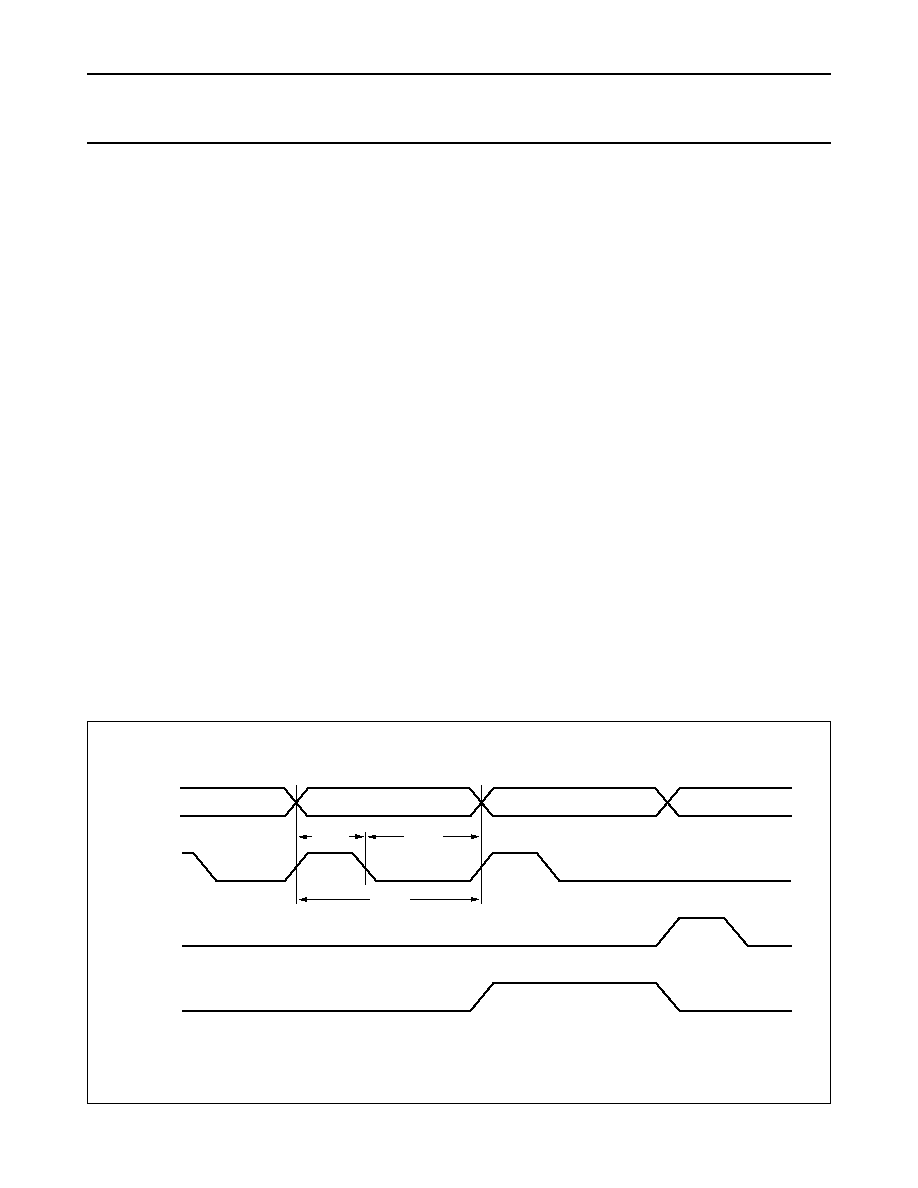
1997 Jan 29
11
Philips Semiconductors
Objective specification
Integrated MPEG2 AVG decoder
SAA7201
FUNCTIONAL DESCRIPTION
General
The SAA7201 is an MPEG2 decoder which combines
audio decoding, video decoding and enhanced region
based graphics. The decoder operates with a single
16 Mbit external synchronous dynamic random access
memory (SDRAM) and runs from a single external 27 MHz
clock. Due to the optimized memory control for MPEG2
decoding, more than 1 Mbit is available for graphics in
50 Hz systems.
MPEG2 data can be accepted up to 9 Mbytes/s through a
dedicated byte wide interface. The data on this interface
can be either in PES (Packetized Elementary Stream),
MPEG1 packet or ES (Elementary Stream) format as
described in Chapter "References". Two additional strobe
signals distinguish between audio and video data.
The internal video decoder is capable of decoding all
MPEG compliant streams up to main level main profile as
specified in Chapter "References". The audio decoder
implements 2 channel audio decoding according to the
standards in Chapter "References".
All real time audio/video decoding and synchronization
tasks are performed autonomously, so the external
microcontroller only needs to perform high-level tasks like
initialization, status monitoring and trick mode control.
The main support task of the external microcontroller
concerns the control of the graphical unit. This unit should
be supplied with bit-maps, determining the contents of the
graphical regions and by a simple set of instructions
determining the appearance of the graphical data on the
screen. Most graphical information should be stored in the
external memory which implies multiple data transfers
between CPU and the external memory. By performing
these data transfers on a direct memory access (DMA)
basis, full bit-maps can be transferred within one video
frame period.
The video output, containing a mix of MPEG video and
graphical data, is at a YUV multiplexed format which can
be directly connected to an external composite video
encoder. The audio output, containing a mix of MPEG
audio and programmable `beeps', is in a serial, I
2
S or
Japanese format which can be directly supplied to most
commercially available up-sampling audio DA converters.
A functional block diagram of the decoder is given in Fig.1.
Its application environment is depicted in Fig.24. In the
following sections, a brief description of the individual
internal blocks of the MPEG2 decoder will be given.
Audio/video interface
In a basic set-top box application the SAA7201 receives
audio and video PES data in a byte wide format at rates up
to 9 Mbytes/s. A timing diagram is shown in Fig.3. Next to
the 8-bit wide data bus an audio and video strobe is
expected at the input. Erroneous data may be flagged via
the error indicator.
handbook, full pagewidth
V_STROBE
A_STROBE
ERROR
AV_DATA
(0 to 7)
25 ns
25 ns
111 ns
video byte (n)
video byte (n + 1)
audio byte (m)
MGD323
Fig.3 Timing diagram of parallel input mode.
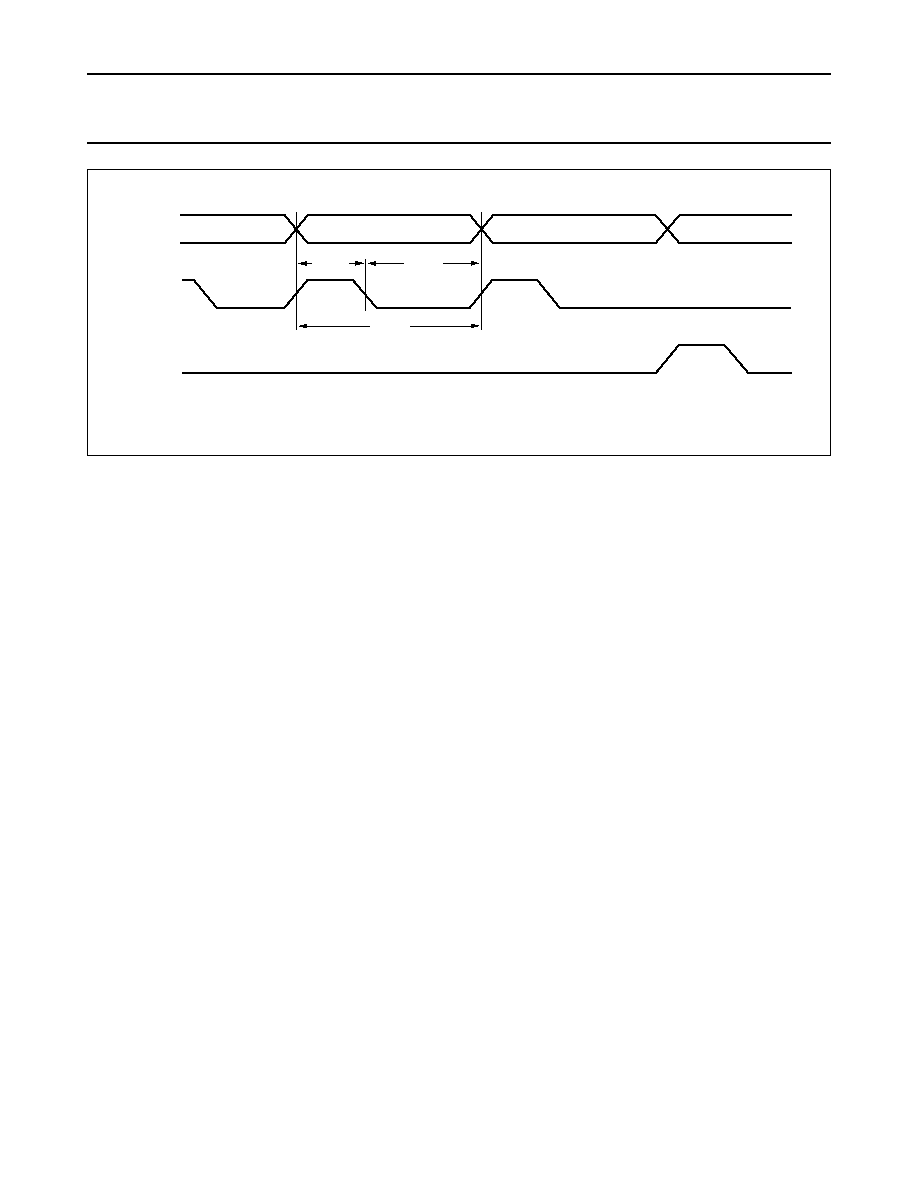
1997 Jan 29
12
Philips Semiconductors
Objective specification
Integrated MPEG2 AVG decoder
SAA7201
Fig.4 Timing diagram of serial input mode.
handbook, full pagewidth
V_STROBE
A_STROBE
AV_DATA0
25 ns
25 ns
50 ns
video bit (n + 6)
video bit (n + 7)
audio bit (m + 0)
first bit of a byte
MGD324
Alternatively data can be received in a 1-bit serial format at
rates up to 20 Mbit/s. In this mode, data is input at the LSB
input of the AV_DATA bus. Audio and video data must be
input in multiples of 8 bits. The first bit after switching from
audio to video (or the other way around) must be the first
bit of a byte since this transition will be used for the internal
bit-to-byte conversion.
Audio/video data can also be received via the CPU
interface in 8 or 16-bit mode. The peak rate is 27 Mbytes/s
in bursts of
128 bytes with a sustained rate up to
9 Mbytes/s. However, the MPEG bit rate is still limited to
15 Mbit/s for video and 448 kbit/s for audio.
Independent of the input mode all audio and video input
data are stored sequentially in the audio or video input
buffer area of the external memory. The audio and video
data can be either in MPEG2 PES, MPEG1 packet or ES
format.
Memory interface unit
The memory interface takes care of addressing and
control of the 16-Mbit external SDRAM. The SDRAM
should be either JEDEC compliant either the `lite/PC'
version.
Due to memory communication requirements this interface
runs at 81 MHz. The SDRAM types used with the
SAA7201 should be organized as 1M
◊
16, split internally
in two banks, each having 2048 pages of 256 words of
16 bits.
The target SDRAM type is NEC
µ
PD 4516161G5-A12-7FJ
(83 MHz JEDEC version) or NEC
µ
PD 4516421G5-A83-7FJ-PC (83 Mhz PC version).
Clock generation
The clock generation unit generates all the internal
processing clocks, the clock for the system time base
counter and the audio oversampling clock for the audio
DAC. For this purpose a non-integer divider plus a PLL is
implemented. In order to get reliable audio and video
decoding the 27 MHz input clock should be locked
externally to the MPEG time base.
Host interface system
The host interface system handles the communication
between on one side the SAA7201 plus SDRAM and on
the other side the external CPU. The interface consists of
a 16-bit wide data bus plus 8 address lines. It is compatible
with both Motorola's 68xxx and Intel's x86 family.
An optimized interface with the SAA7208 is also
supported. Via this interface a fast direct access to a large
number of internal status and data registers can be
achieved. Moreover, the external SDRAM can be
accessed via a specific register in combination with an
internally implemented auto increment counter.
The access to the external SDRAM is guaranteed up to a
sustained data rate of 9 Mbyte per second. However, in
practice the achievable data rate can be much higher.
Next to the data and address lines, 4 interrupt lines are
part of the host interface bus. Each interrupt line can
monitor up to 32 internal events which all can be masked
individually. Examples of internal events are audio/video
bit stream information, decoder status, internal error
conditions and input buffer occupation. The latter may be
very useful in interactive applications to serve as input data
request line.

1997 Jan 29
13
Philips Semiconductors
Objective specification
Integrated MPEG2 AVG decoder
SAA7201
System time base unit
The system time base unit serves as a timing master for all
internal processes. It consists of two 24-bit wide System
Time Clock (STC) counters, running at 90 kHz. The STCs
will be used as internal synchronization reference for audio
and video.The contents of the STC can be loaded by the
external CPU which should insure that the phase of the
SAA7201 internal STC is identical to the main system time
clock in the system demultiplexer. The CPU should correct
for possible latency problems.
Because two counters are implemented, the previous time
base reference which might still be required as reference
for some time in case of time base discontinuity, can be
maintained. Thus all information for audio/video
synchronization is available in the decoder chip and only
minor support of the external controller is required.
The synchronization of graphics for e.g. subtitling, should
be controlled by the external CPU.
Video input buffer and synchronization control
The size and position of the video input buffer in the
external SDRAM is programmable. By default 2.6 Mbit/s
are reserved for the video input buffer but in principle any
other value can be programmed. The current fullness of
the video input buffer can be monitored by the CPU and an
internal interrupt will be generated is case of either near
over- or near underflow.
Data retrieval from the input buffer can be controlled by
DTS time stamps parsed from the PES or MPEG1 packet
stream. For those frames where no DTS time stamp is
present in the video bitstream a DTS is emulated by the
SAA7201.
Obviously this emulation mode can also be used when the
input stream is a video elementary stream (ES). The latter
case should be handled by start and stop decode
commands from the CPU.
The external CPU can select to retrieve the video PES
header and/or video PES private data for further software
processing.
Audio input buffer and synchronization control
The audio input buffer and synchronization control
basically behaves identical to its video counter part.
The default buffer size is 64 kbit in this case.
Synchronization will be controlled by PTS time stamps in
the audio Packetized Elementary Stream. Also in this case
an PTS emulation or a free running start/stop controlled
mode are supported.
Audio decoder
A functional block diagram for the audio decoding part is
depicted in Fig.5.
Fig.5 Audio decoding unit.
handbook, full pagewidth
BUFFER AND
SYNC UNIT
AUDIO
CLOCK
GENERATOR
AUDIO
BEEP
DRAM-bus
81 MHz
MPEG
AUDIO
DECODER
OUTPUT
INTERFACE
Sony or
I
2
S-bus
SPDIF
MGD325
Audio decoding unit
+
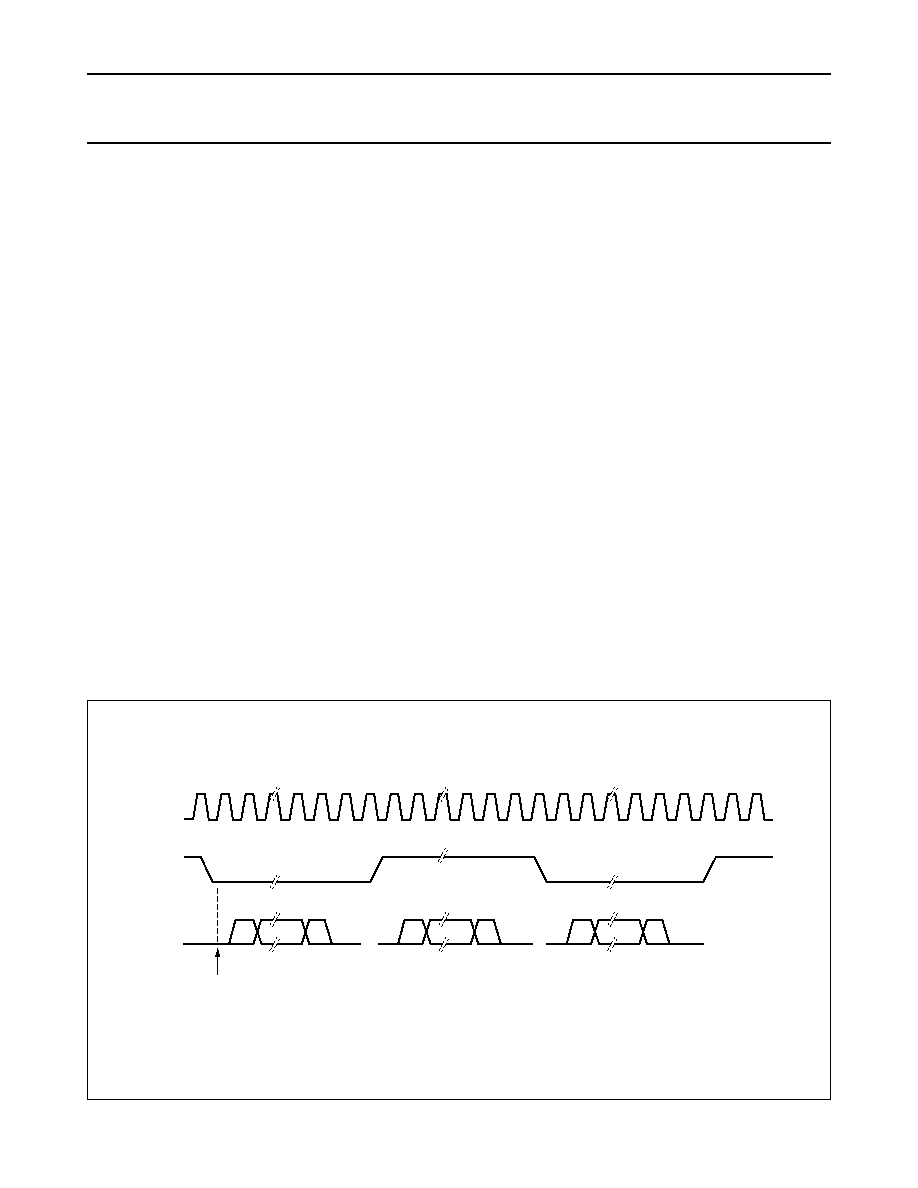
1997 Jan 29
14
Philips Semiconductors
Objective specification
Integrated MPEG2 AVG decoder
SAA7201
Audio decoding will be performed at a clock locked to the
video decoding clock and only the output interface is
running on the audio oversampling clock.
The audio decoder unit performs the decoding of the
selected MPEG audio stream in a range from 8 up to
448 kbit/s in a fixed or variable bit rate format. Decoding is
restricted to 2 channel, layer I, II MPEG audio at sampling
frequency of 48.0, 44.1, 32.0, 24.0, 22.05 or 16.0 kHz.
The audio decoder support the stop, mute, and skip
function to support insertion
Apart from basic MPEG processing the audio decoder
core contain also:
∑
Support for: stop, mute and skip function.
∑
Fully parameterized dynamic range compression unit to
decrease the dynamic range of the output signal on
audio frame basis. Depending on the power level a
programmable amplification and offset may be applied.
∑
Fully programmable base band audio processing unit to
control the gain in both output channels independently
and/or to mix both channels.
∑
MPEG de-emphasis filtering on the output data, thus
avoiding the need of external analog de-emphasis filter
circuitry.
∑
Storage buffer for the last 54 bytes of each audio frame.
The CPU can retrieve eventual ancillary data from this
buffer.
The output of the audio decoder unit can be mixed with
square waveform audio signals which are generated by a
beep generator. Programmable parameters for the beep
generator are amplitude, frequency and duration.
The audio output interface module produces stereo base
band output samples on two different outputs at the same
time:
∑
Serial digital audio in I
2
S-bus or in Japanese format in
16, 18, 20 or 22-bit
∑
SPDIF (Sony/Philips Digital Interface).
Any of the two outputs may be enabled or set to high
impedance mode. The I
2
S-bus format with 18-bit sample
precision is shown in Fig.6.
The difference between I
2
S-bus and the Japanese format
is that I
2
S-bus is MSB aligned whereas the Japanese
format is LSB aligned.
The 1-bit serial interface SPDIF contains 64-bit per audio
sample period. Complete frames must be transmitted at
the audio sample rate. Not only left/right information but
also validity flags, channel status, user data and parity
information is contained in an SPDIF frame (see Chapter
"References").
Fig.6 I
2
S-bus format with 18-bit sample precision.
handbook, full pagewidth
b17
MSB aligned
MGD326
left sample n
left sample n + 1
right sample n
0
31
32
63
SCLK
WS
SD
b0
b17
b0
b17
b0
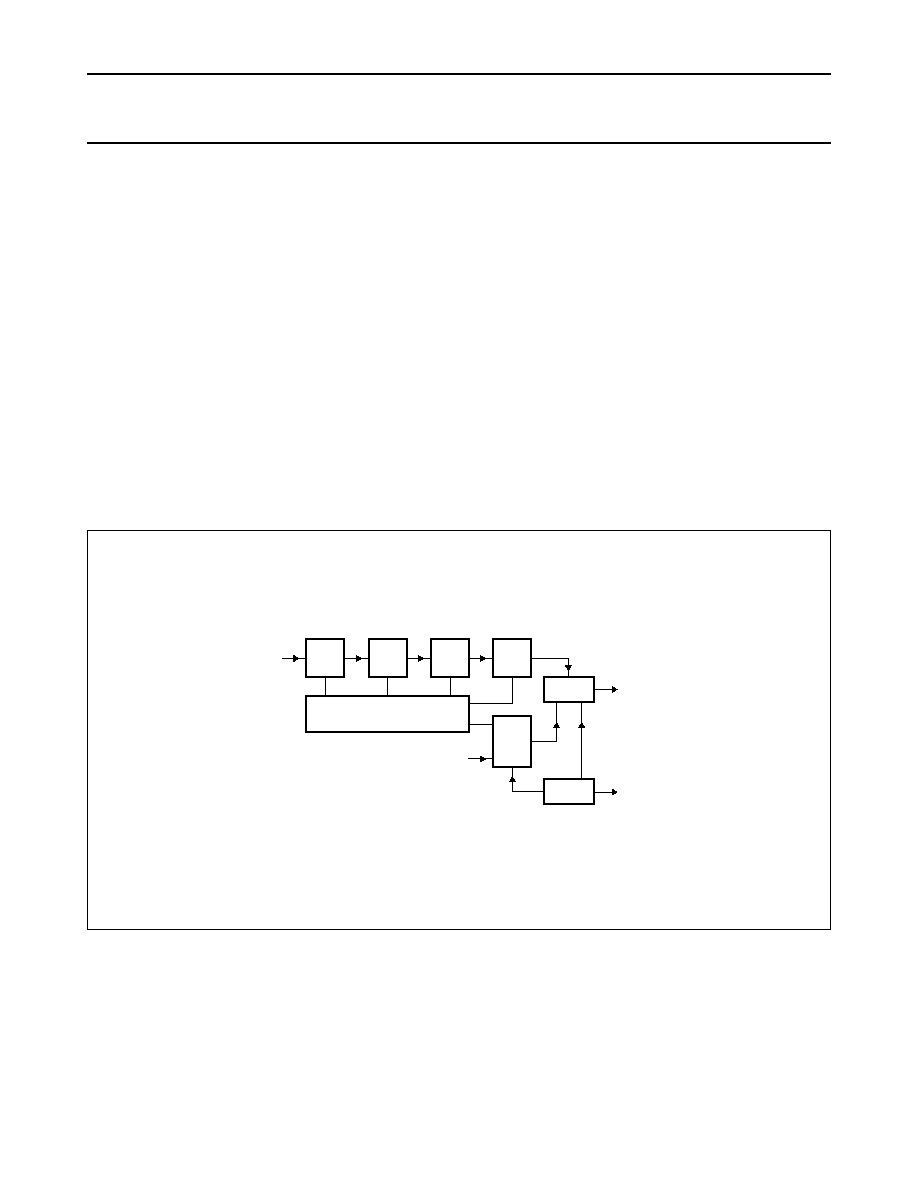
1997 Jan 29
15
Philips Semiconductors
Objective specification
Integrated MPEG2 AVG decoder
SAA7201
Video decoder
The video decoding unit provides all actions required for
compliant decoding of MPEG2 main level, main profile
coded video bit streams. The decoding process consists of
fixed and variable length decoding, run length decoding,
inverse quantization, inverse discrete cosine
transformation, motion compensation and interpolation.
In general the arithmetic decoding result is stored as
reference picture in the external memory.
Decoded B-frames are only stored for the conversion from
the frame coded macro block (MB) to the scanning line
format. In many cases a field storage is sufficient for this
conversion but in some cases the user might decide to use
a full frame storage to enable chroma frame up-conversion
or full performance 3 : 2 pull-down in 60 Hz systems.
Obviously when using less memory for the video decoding
process more memory is available for non-video decoding
tasks.
The Frame Buffer Management unit (FBM) manages the
allocation of frame buffers in external SDRAM for both
video decoding and display unit and can be programmed
to use less memory in not fully MP@ML bitstreams:
smaller pictures (e.g. 544
◊
576), simple profile, etc.
Apart from decoding compliant MPEG video streams the
decoder deals with some trick modes. Supported are field
or frame freeze at I or P pictures or freeze field on
B-pictures. In the latter case decoding will continue as a
background process and the output can be restarted at
any moment. When receiving non-compliant MPEG
streams the decoder can be switched to a scanning mode
in which only I or I + P frames are decoded while skipping
all other pictures. In the single step mode, the decoder
decodes just one frame and awaits a next step command.
The functional diagram of the video decoding unit is shown
in Fig.7.
Fig.7 Video decoding unit.
handbook, full pagewidth
VLD
FLD
IZZ
IQ
IDCT
MC
INTERP
FBM
to display
unit
to external
memory
from reference
memory
from
input
buffer
MGD327
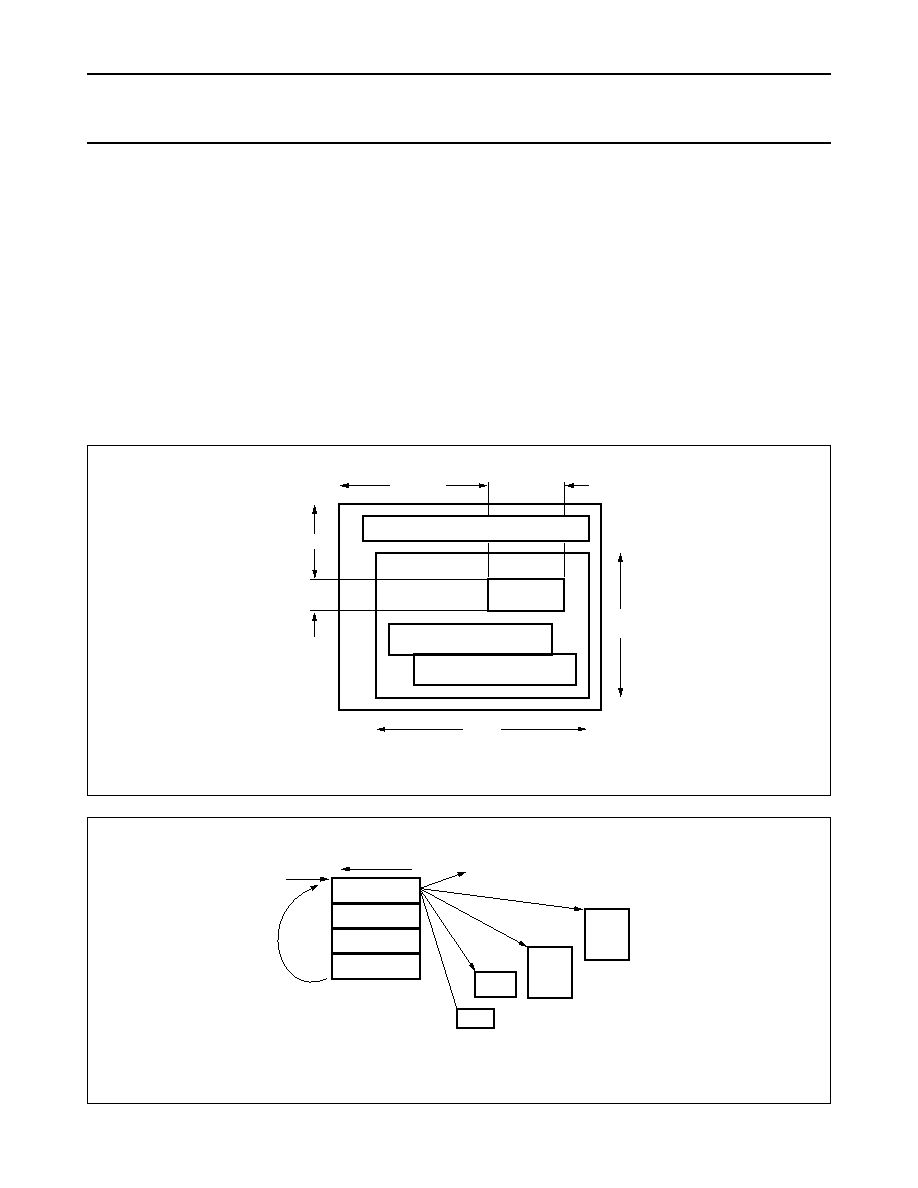
1997 Jan 29
16
Philips Semiconductors
Objective specification
Integrated MPEG2 AVG decoder
SAA7201
Graphics unit
The SAA7201 incorporates the display support for pixel
based graphics. Possible applications are the user
interface, logos and subtitling. Graphical data should be
grouped logically in regions and will be displayed in boxes
at the screen.
The definition of each region in the decoder consists of
four parts being a region descriptor, a top-field descriptor,
a bottom-field descriptor and a table-data descriptor:
∑
The region descriptor contains information relevant for
the full region like format, size, position and pointers to
the other descriptors.
∑
The top-field and bottom-field descriptor contain a pixel
based bit-map for the contents of that region for both
fields independently. The bit-maps can be stored in
either straight forward or in a compressed bit-map
format.
∑
The table-data descriptor defines the tables to be used
for the transformation of bit-maps to display colours.
All descriptors should be loaded under control of the
external CPU in the external memory.
The appearance of graphical data at the display is
determined by the assembly of region descriptors in a so
called display list. An example of such a display list for the
4 regions example is shown in Fig.9.
Fig.8 Graphics unit.
handbook, full pagewidth
REGION-1 (VBI-SIGNALS)
REGION-2
active
video
REGION-3 (256 ENTRY CLUT)
REGION-4
MGD328
active
video
H-size (2)
H-start (2)
V-start (2)
V-size (2)
Fig.9 Display list.
handbook, full pagewidth
DESCRIPTOR 1
MAP
CLUT
bottom-field
top-field
table
data
PIXEL
DATA
PIXEL
DATA
128 bit
gfx
anchor
address
eodl
position, size, format
pointers to locations in SDRAM
DESCRIPTOR 2
DESCRIPTOR 3
DESCRIPTOR 4
MGD329

1997 Jan 29
17
Philips Semiconductors
Objective specification
Integrated MPEG2 AVG decoder
SAA7201
Basically there is no restriction on the number of different
regions but because regions may not vertically overlap the
practical limit will be the number of lines within a field.
However, one should realize that each region requires its
own 128-bit region descriptor.
The display list will be scanned twice per frame, once for
each display field. The region descriptors should be
ordered properly in the external SDRAM, starting from the
graphics anchor address. The last descriptor in the list
must have the end of display list indicator set.
Multiple pixel bit-maps, CLUTs and map tables may be
stored in the external memory but per region only two
bit-maps (one for each fields) and two tables
(CLUT + map table) may be used. Obviously bit-maps and
tables may be shared by multiple regions.
Pixel data bit-maps can be described in 2, 4 or 8 bit/pixel
in either a direct bit-map or coded in a one-dimensional (H)
variable and run length encoded format according the
pixel-data-sub-block syntax as specified in Chapter
"References" and illustrated in Chapter "Appendix".
The actual coding format is specified in the region
descriptor for each region thus allowing different coding
schemes within a picture.
During display the 2, 4 and 8 bit/pixel bit-maps will be
transformed, eventually with run length decoding, via a
table look-up mechanism into a 4, 16 or 256 different YUV
colours with 8-bit resolution for each component plus a
factor T for mixing of graphics and MPEG video.
In order to obtain maximum flexibility two cascaded tables
are active in this bit-map to pixel conversion as indicated
in Fig.10.
The tables are retrieved from the external memory just
before the region is going to be displayed. One table per
region can be updated and for small tables this occurs
during the horizontal blanking interval. However, updating
a 256 entry CLUT may take about one line period which
means that a spatial separation of one line with the
previous region is mandatory in this case. If the required
tables for a certain region are already stored in the local
memory, the table down load action can be skipped.
Additionally some special bits can be set in the region
descriptor.
∑
Transparency shift: this parameter overrules the pixel
based transparency in order to support fading of the
entire graphical region.
∑
Zoom: this parameter initiates horizontal pixel repetition.
It should be noted that a copy of pixels in vertical
direction can be achieved by pointing to a single bit-map
for both fields.
Regions can also be defined in the vertical blanking
interval. In combination with 8 bit/pixel coding, arbitrary
test signals on 13.5 MHz grid can be programmed.
Possible application areas are teletext, closed caption,
wide screen signalling bits, Video Programming Signals
(VPS) and Vertical Interval Test Signals (VITS).
As indicated above multiple regions can be specified in a
display list which will be scanned sequentially every frame.
In case of stationary graphics no updates of the display list
are required, but the external CPU can update it
dynamically to achieve scrolling and/or fading of one or
more graphical boxes. The display list mechanism also
allows for non real time transfer of large bit-maps by
keeping that region out of the display list during loading.
Fig.10 Bit-map to pixel conversion.
handbook, full pagewidth
8
4 LSBs
2 LSBs
2 LSBs
4 LSBs
8 LSBs
8
CLUT
8
8
MGD330
MAP
TABLE 4 to 8
MAP
TABLE 2 to 8
8
Y
U
V
T
8
8
8

1997 Jan 29
18
Philips Semiconductors
Objective specification
Integrated MPEG2 AVG decoder
SAA7201
C
URSOR PROCESSING
Additionally to the above defined graphics boxes one
cursor can be activated on the screen. Since the cursor
data is fully stored locally, no overlapping restriction apply
to this box so the cursor can moved over the entire screen.
The cursor can be as large as 1 kpixel with a 2 bits/pixel
colour depth. Obviously data transfer can be done on DMA
basis and need only be performed when a cursor is
required or when its contents must be modified.
The cursor XY dimensions (where the Y dimension refers
to frame lines) can be selected between 8
◊
128, 16
◊
64,
32
◊
32, 64
◊
16 and 128
◊
8. On top of these shapes, a
zoom with a factor 2 can be applied in both directions
independently.
The cursor pixels will be translated via a 4-entry CLUT to
YUV colours and a transparency factor T. The resolution
of the YUV parameters is 6, 4, 4 bits respectively.
The T parameter is coded in 2 bits to enable the mixing
with video and graphics in 4 steps being 100% (cursor
only), 50%, 25% and 0% (fully transparent cursor).
Display unit
Before feeding the MPEG decoded and graphical data to
the output, a display unit re-formats the MPEG specific
4 : 2 : 0 format to CCIR-601 4 : 2 : 2 format and performs
a mixing between video and graphics where required.
The output picture can be up to 720
◊
576 pixels at 50 Hz
or 720
◊
480 pixels at 60 Hz.
A schematic representation of this unit is shown in Fig.11.
∑
In a first step a selected window can be retrieved from
the decoded MPEG data. This might be useful for e.g.
pan and scan operations for aspect ratio conversion.
∑
In case the resulting number of pixels per line does not
match the 720 pixels/line output format a horizontal
scaler can be activated. This scaling unit can transform
any number of bits below 720 to the required output
format. Internally a poly-phase filter is used which
performs a 64 phases interpolation. Not only
up-conversion but also down-conversion is supported
up to a scaling by a factor 2. Thus horizontal scaling can
be performed in a range from 0.5 up to 64. In practice
the maximum up-conversion factor will be less or equal
to 4.
∑
In vertical direction the picture can be expanded or
scaled down, in both cases by a factor 2. Expansion with
a factor 2 might be relevant for the up-conversion of SIF
resolution pictures to full screen. The factor 2 scaling, if
combined with the appropriate horizontal scaling, results
is
1
/
4
picture thus freeing-up a large screen area for
graphics. This might be very useful for electronic
program guide applications. It should be noted that in
case of picture compression an anti-aliasing filter can be
activated.
∑
Shifting: when the resulting MPEG picture is smaller
than the 720
◊
576 (480) display format, this picture can
be located anywhere on the display screen.
Moreover, the non-covered area can be given any
background colour.
∑
Clipping: the amplitude of the MPEG decoded and
re-scaled video signal is kept within the range 16 to 235
for luminance and 16 to 240 for both chrominance
components.
Fig.11 Display unit.
handbook, full pagewidth
WINDOW
EXTRACTION
SCALING
64 STEP
MIXER
4 STEP
MIXER
GRAPHICS
CURSOR
OUTPUT
FORMAT
to digital
CVBS
encoder
SHIFTING
CLIPPING
CHROMA
UP-CONVERSION
MPEG
decoded
picture
MGD331
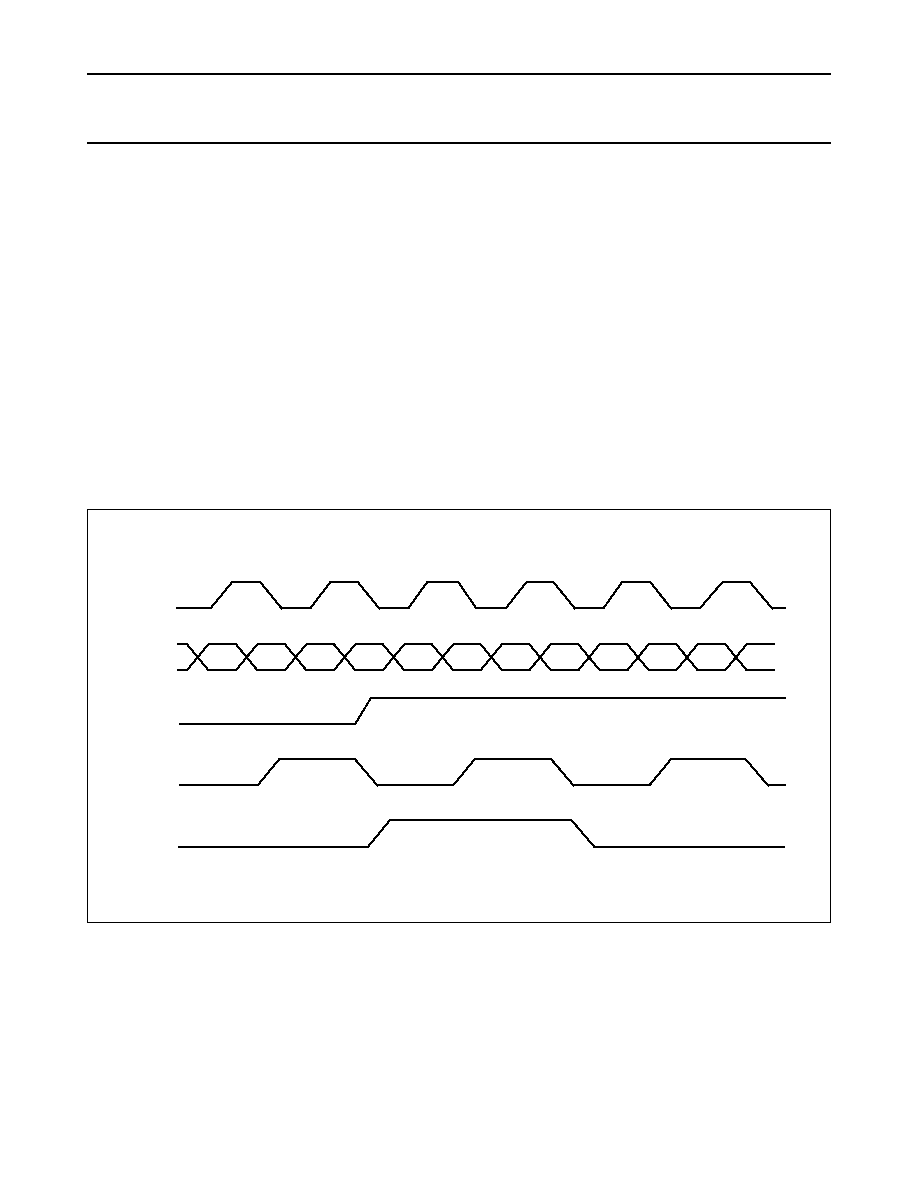
1997 Jan 29
19
Philips Semiconductors
Objective specification
Integrated MPEG2 AVG decoder
SAA7201
∑
The chroma up-conversion unit converts the MPEG
4 : 2 : 0 format into the at the output required
4 : 2 : 2 format. This vertical up-conversion is performed
by a simple 8-phase interpolation between two adjacent
lines.
∑
The mixer units combine MPEG video with graphics and
cursor information in two steps. In a first step the MPEG
decoded information is mixed with graphical information.
Mixing can be done at pixel basis in 64 steps and is
controlled by the internally implemented colour look up
table. In a second step, the video plus graphics can be
mixed in 4 steps with the internally generated cursor.
∑
The output formatting unit performs two main tasks, i.e.
synchronization and formatting. Synchronization is
characterized by three signals being horizontal (H),
vertical (V) and field parity (FP), all having
programmable length and polarity.
Since the decoder can operate in master or slave mode,
the synchronization signals can be generated by the
decoder or should be delivered by an external device.
In both cases the length and polarity should be
programmed internally.
The video output samples are supplied in a multiplexed
YUV format to the output. Next to this byte wide YUV
stream, which can directly be supplied to most
commercially available composite video encoder ICs,
three additional signals are delivered at the output.
HREF indicates all active samples; CREF can flag any
combination of pixels: U, V, Y
odd
and/or Y
even
; GRPH
flags all the pixels inside a graphical box.
Additionally the full YUV bus can be set to a HIGH
impedance state under control of the signal YUV_ENA.
This might be useful for multiplexing the MPEG decoder
output with any other signal source on static basis.
Fig.12 Timing diagram of graphics information output.
handbook, full pagewidth
CLK
YUV
HREF
CREF
(example)
GRPH
'128'
'16'
U0
Y0
V0
Y2
MGD332

1997 Jan 29
20
Philips Semiconductors
Objective specification
Integrated MPEG2 AVG decoder
SAA7201
JTAG
The SAA7201 supports the standard Boundary Scan test
instructions: bypass, extest, sample, intest, runbist,
idcode.
Memory requirements
As indicated before the MPEG source decoder operates
with 16 Mbit of external memory. Several processes
require access to the external memory, mostly being the
video decoding process. In normal main level, main profile
video applications about 1.2 Mbit of memory space is free
for non-video processes. In practice most of this capacity
will be used for graphics. In combination with the internal
variable length decoding, full screen graphics at 8-bit per
pixel is feasible. Moreover, by having introduced a flexible
memory allocation procedure the available memory
capacity for graphics may be enlarged when decoding
lower resolution MPEG pictures or when the input bit rate
is less than 15 Mbit/s.
Obviously for graphics-only applications all 16 Mbit can be
used for the storage of bit-maps and look-up tables.
In Table 1 an overview is given of the required memory
capacity for some user defined modes.
In 50 Hz systems memory capacity can be saved by
restricting the chroma vertical interpolation to field
interpolation. This mode would only bring some extra
chroma resolution in case the input stream contains
progressive coded pictures.
In 60 Hz systems the reduction of storage capacity for
B-frames to field capacity has not only consequences for
the chroma vertical interpolation but also for the
3 : 2 pull-down operation mode. The operation
repeat-first-field is not possible in all cases and a modified
3 : 2 pull-down is performed under the control of the
SAA7201. The user may decide to use this modified
3 : 2 pull-down mode in order to have more memory
available for OSD or graphics.
Table 1
Required memory capacity for some user defined modes
System
50 Hz
60 Hz
Bit rate (R)
15 Mbit/s
15 Mbit/s
9 Mbit/s
Chroma interpolation
frame
field
field
frame
field
field
3 : 2 pull-down
n.a.
n.a.
n.a.
full MPEG
modified
modified
Picture format
720
◊
576
720
◊
576
544
◊
576
720
◊
480
720
◊
480
720
◊
480
Audio input buffer
64 kbit
64 kbit
64 kbit
64 kbit
64 kbit
64 kbit
Video input buffer
1835 kbit
1835 kbit
1835 kbit
1835 kbit
1835 kbit
1835 kbit
Video implementation buffer (R/P)
600 kbit
600 kbit
400 kbit
500 kbit
500 kbit
300 kbit
Slave synchronization buffer (R/2P)
300 kbit
300 kbit
200 kbit
250 kbit
250 kbit
150 kbit
Reference and decoded picture
13456 kbit
12719 kbit
9609 kbit
12441 kbit
10634 kbit
8042 kbit
Total for video + audio
16255 kbit
15518 kbit
12108 kbit
15090 kbit
13292 kbit
10391 kbit
Remains for OSDG (2
24
= 16777 kbit)
522 kbit
1259 kbit
4669 kbit
1687 kbit
3485 kbit
6386 kbit

1997 Jan 29
21
Philips Semiconductors
Objective specification
Integrated MPEG2 AVG decoder
SAA7201
LIMITING VALUES
In accordance with the Absolute Maximum Rating System (IEC134).
THERMAL CHARACTERISTICS
SYMBOL
PARAMETER
CONDITIONS
MIN.
MAX.
UNIT
V
DD
supply voltage (on all supply pins)
3.0
3.6
V
V
max
maximum voltage on all pins
0
5.5
V
P
tot
total power dissipation
T
amb
= 25
∞
C
-
tbf
W
T
stg
storage temperature
-
55
+150
∞
C
T
amb
operating ambient temperature
0
+70
∞
C
SYMBOL
PARAMETER
VALUE
UNIT
R
th j-a
thermal resistance from junction to ambient in free air
30
K/W
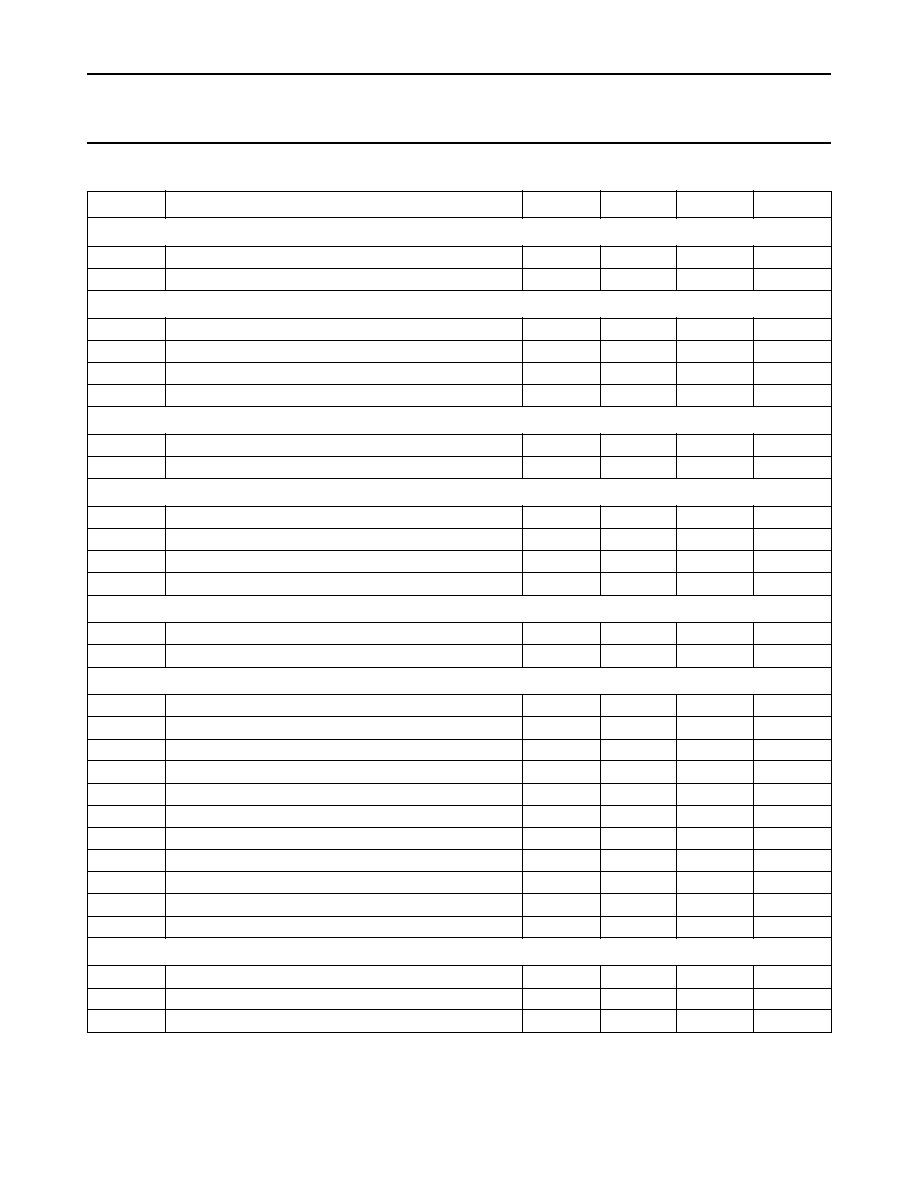
1997 Jan 29
22
Philips Semiconductors
Objective specification
Integrated MPEG2 AVG decoder
SAA7201
CHARACTERISTICS
SYMBOL
PARAMETER
MIN.
TYP.
MAX.
UNIT
Supply
V
DD
supply voltage
3.0
3.3
3.6
V
I
DD
supply current
-
tbf
-
mA
Inputs
V
IH
HIGH level input voltage
2.0
-
V
DD
+ 2.0
V
V
IL
LOW level input voltage
-
0.5
-
0.8
V
I
LI
leakage current
-
-
20
mA
C
i
input capacitance
0
-
10
pF
Outputs
V
OH
HIGH level output voltage
2.4
-
-
V
V
OL
LOW level output voltage
-
-
0.4
V
CLK timing
T
C
cycle time
37.036
37.037
37.038
ns
duty factor
40
-
60
%
t
r
rise time
2
-
4
ns
t
f
fall time
2
-
4
ns
Input timing with respect to CLK rising edge
t
su
set-up time
8
-
-
ns
t
h
hold time
0
-
-
ns
Timing (see Figs. 13, 14, 15, 16, 17, 18, 19, 20, 21, 21 and 21)
t
su(A-CS)
address/CS set-up time
20
-
-
ns
t
h(A-CS)
address/CS hold time
75
-
-
ns
t
su(D-W)
data write set-up time
20
-
-
ns
t
su(D-R)
data read set-up time
20
-
-
ns
t
rel(D)
data release time
0
-
10
ns
t
h(CT)
control signal hold time
0
-
-
ns
t
W(ACK)
acknowledge pulse width
25
-
-
ns
t
rel(ACK)
acknowledge release time
0
-
10
ns
t
d(ACK-R)
delay time for acknowledge read
96
-
125
ns
t
d(ACK-W)
delay time for acknowledge write
48
-
75
ns
t
W(RW)
write/read pulse width
25
-
-
ns
Output timing with respect to CLK rising edge
t
h
hold time
3
-
t
d
ns
t
d
delay time
t
h
-
20
ns
C
L
load capacitance
10
-
30
pF

1997 Jan 29
23
Philips Semiconductors
Objective specification
Integrated MPEG2 AVG decoder
SAA7201
handbook, full pagewidth
ADDRESS
DATA
MGD333
ADDRESS
(8 to 1)
CS
DS
DTACK
DATA
(15 to 0)
R/W
tsu(A-CS)
th(A-CS)
tsu(D-W)
th(D)
tW(ACK)
trel
trel(ACK)
td(ACK-W)
tW(RW)
Fig.13 Motorola write timing (non-multiplexed).
handbook, full pagewidth
ADDRESS
DATA
MGD334
ADDRESS
(8 to 1)
CS
DS
DTACK
DATA
(15 to 0)
R/W
tsu(A-CS)
th(A-CS)
tsu(D-R)
tAR
trel(D)
tW(ACK)
trel
trel(ACK)
td(ACK-R)
tW(RW)
Fig.14 Motorola read timing (non-multiplexed).
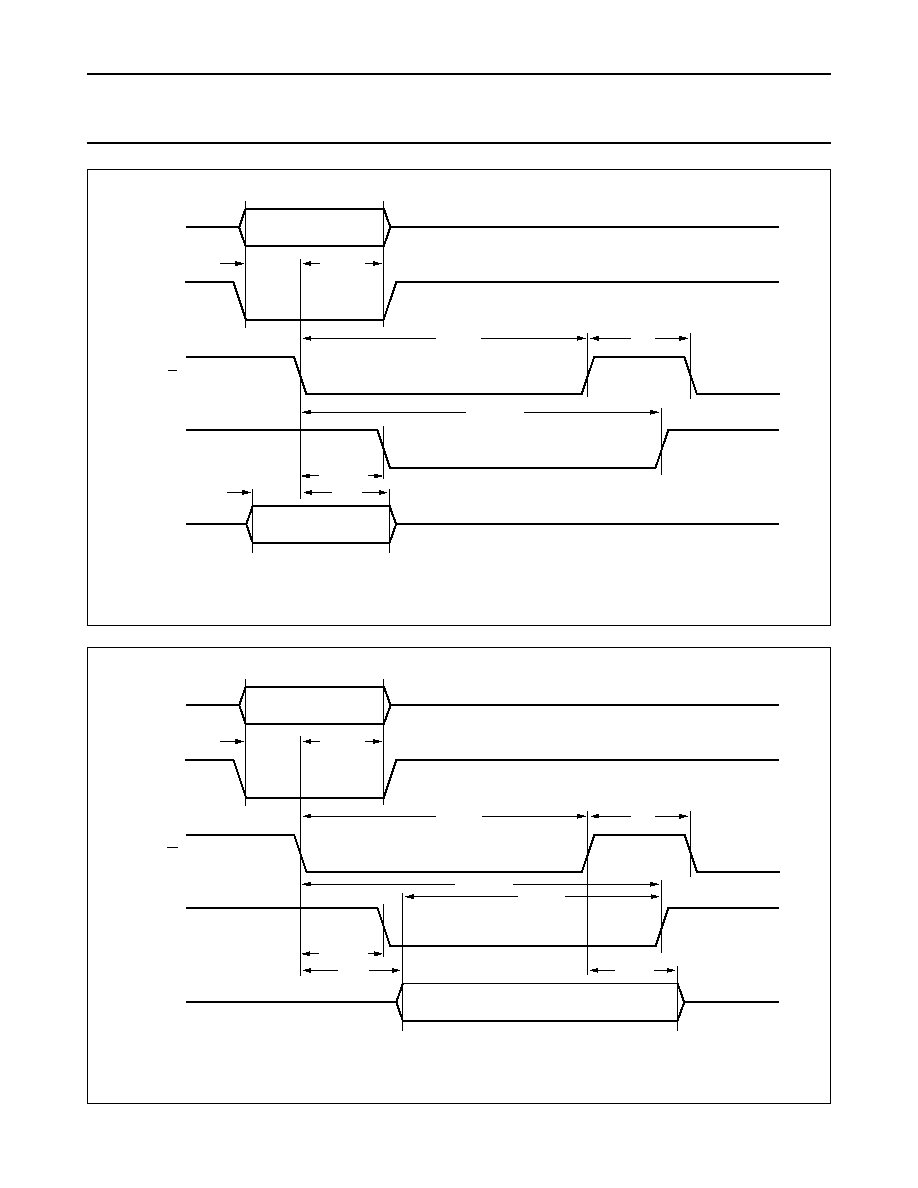
1997 Jan 29
24
Philips Semiconductors
Objective specification
Integrated MPEG2 AVG decoder
SAA7201
Fig.15 Intel write timing (non-multiplexed).
handbook, full pagewidth
ADDRESS
DATA
MGD335
ADDRESS
(8 to 1)
CS
RDY
DATA
(15 to 0)
R/W
tsu(A-CS)
th(A-CS)
tsu(D-W)
th(D)
trel
trel(ACK)
td(ACK-W)
tW(RW)
Fig.16 Intel read timing (non-multiplexed).
handbook, full pagewidth
ADDRESS
DATA
MGD336
ADDRESS
(8 to 1)
CS
RDY
DATA
(15 to 0)
R/W
tsu(A-CS)
th(A-CS)
trel(D)
tAR
tsu(D-R)
trel
trel(ACK)
td(ACK-R)
tW(RW)

1997 Jan 29
25
Philips Semiconductors
Objective specification
Integrated MPEG2 AVG decoder
SAA7201
Fig.17 DMA read access.
handbook, full pagewidth
DATA
MGD337
CS
DMA_ACK
DMA_RDY
DATA
(15 to 0)
DMA_REQ
tsu(A-CS)
th(A-CS)
tsu(D-W)
th(D)
trel
trel(ACK)
td(ACK-W)
tW(RW)
Fig.18 DMA write access.
handbook, full pagewidth
DATA
MGD338
CS
DMA_ACK
DMA_RDY
DATA
(15 to 0)
DMA_REQ
tsu(A-CS)
th(A-CS)
tAR
tsu(D-R)
trel
trel(ACK)
trel(D)
td(ACK-R)
tW(RW)
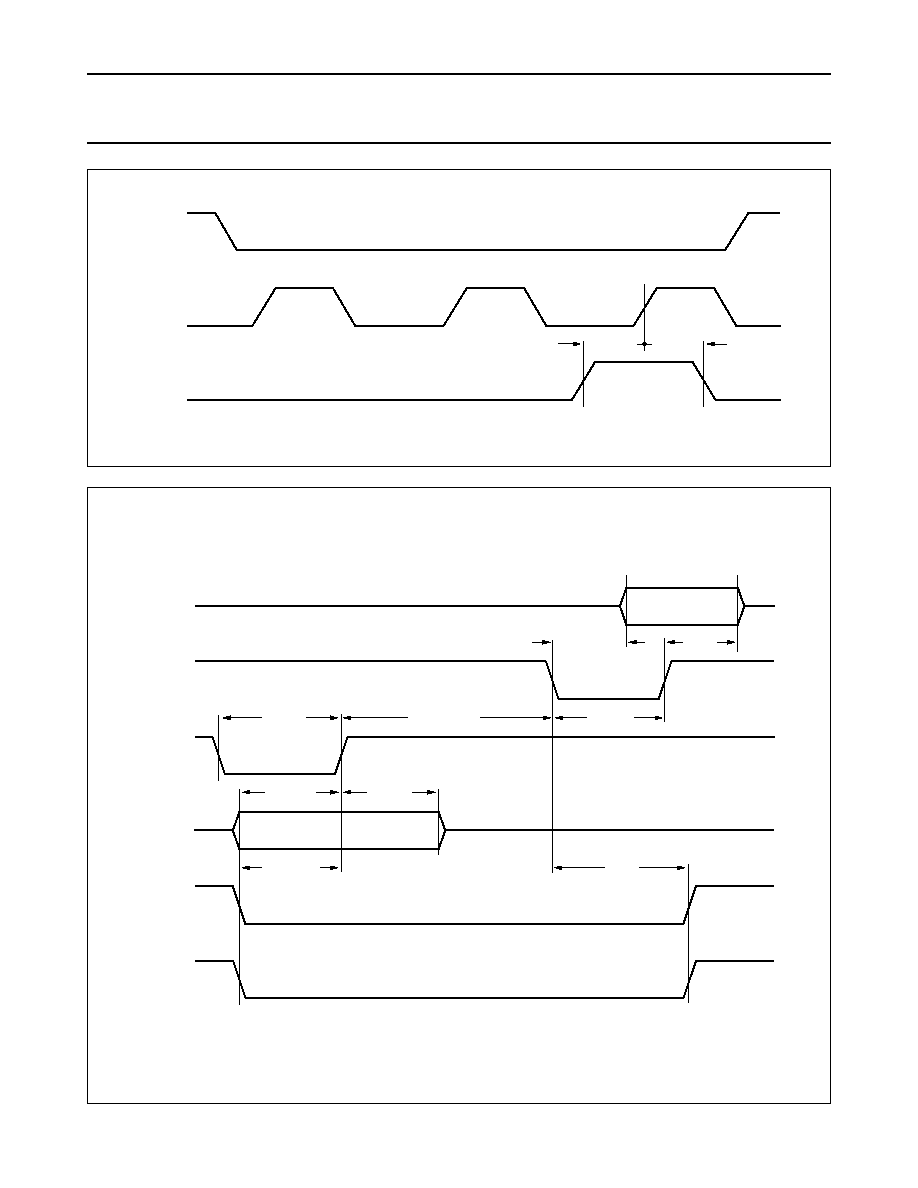
1997 Jan 29
26
Philips Semiconductors
Objective specification
Integrated MPEG2 AVG decoder
SAA7201
Fig.19 DMA_DONE timing.
handbook, full pagewidth
MGD339
DMA_ACK
DMA_DONE
DMA_REQ
tsu(A-CS)
th(A-CS)
Fig.20 SAA7208 mode; read timing.
handbook, full pagewidth
MGD919
ADDRESS
ADDRESS
(8 to 0)
DATA
DATA
(15 to 0)
RDY
ALE
th(CS)
th(CS-ALE)
tW(ALE)
tW(SDR)
trel(D)
tsu(SDR-D)
tsu(ALE-SDR)
tsu(A-CS)
th(A-CS)
CS
SYSRD
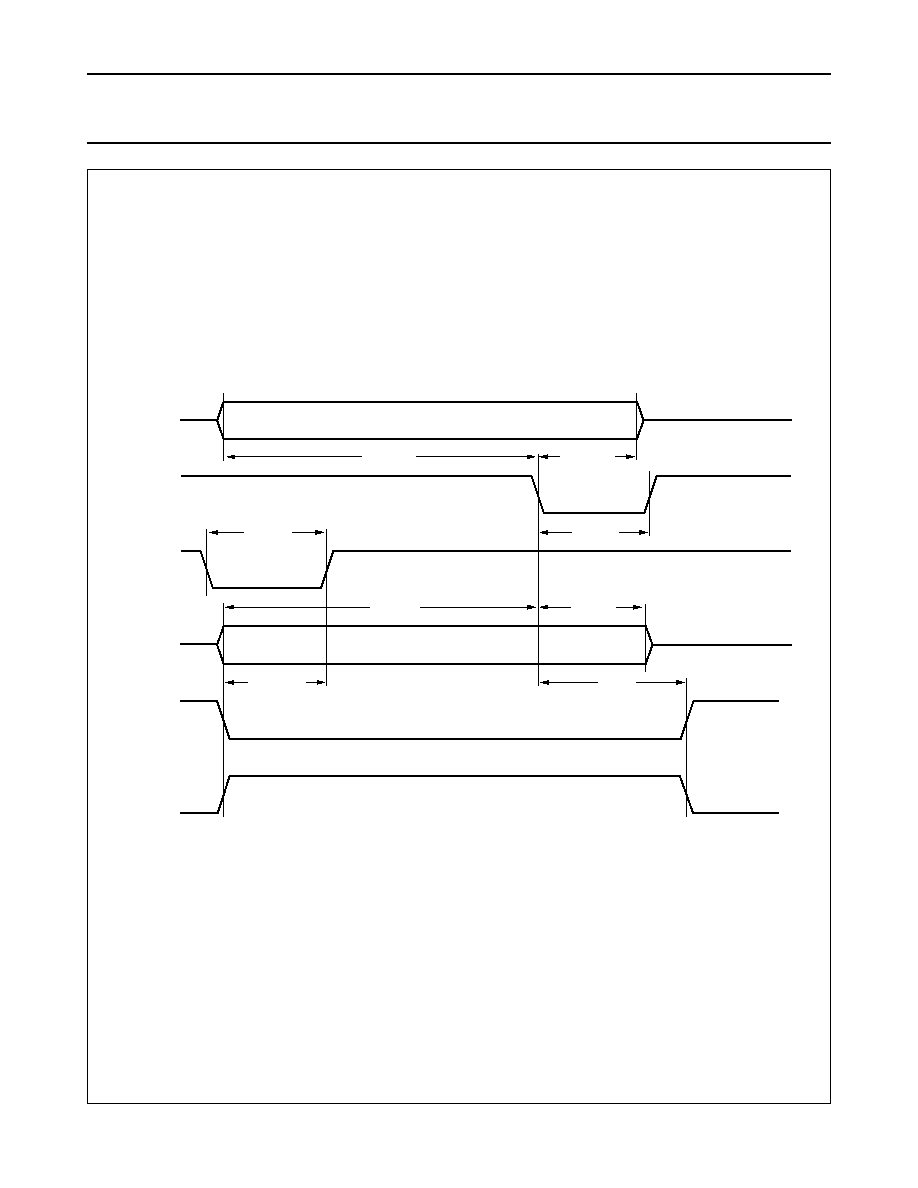
1997 Jan 29
27
Philips Semiconductors
Objective specification
Integrated MPEG2 AVG decoder
SAA7201
Fig.21 SAA7208 mode; write timing.
handbook, full pagewidth
MGD918
DATA
(15 to 0)
ADDRESS
(8 to 0)
CS
SYSRD
RDY
DATA
ADDRESS
ALE
th(CS)
th(A-CS)
tsu(A-CS)
th(CS-ALE)
tW(SDR)
tW(ALE)
tW(D-SDR)
th(D-SDR)
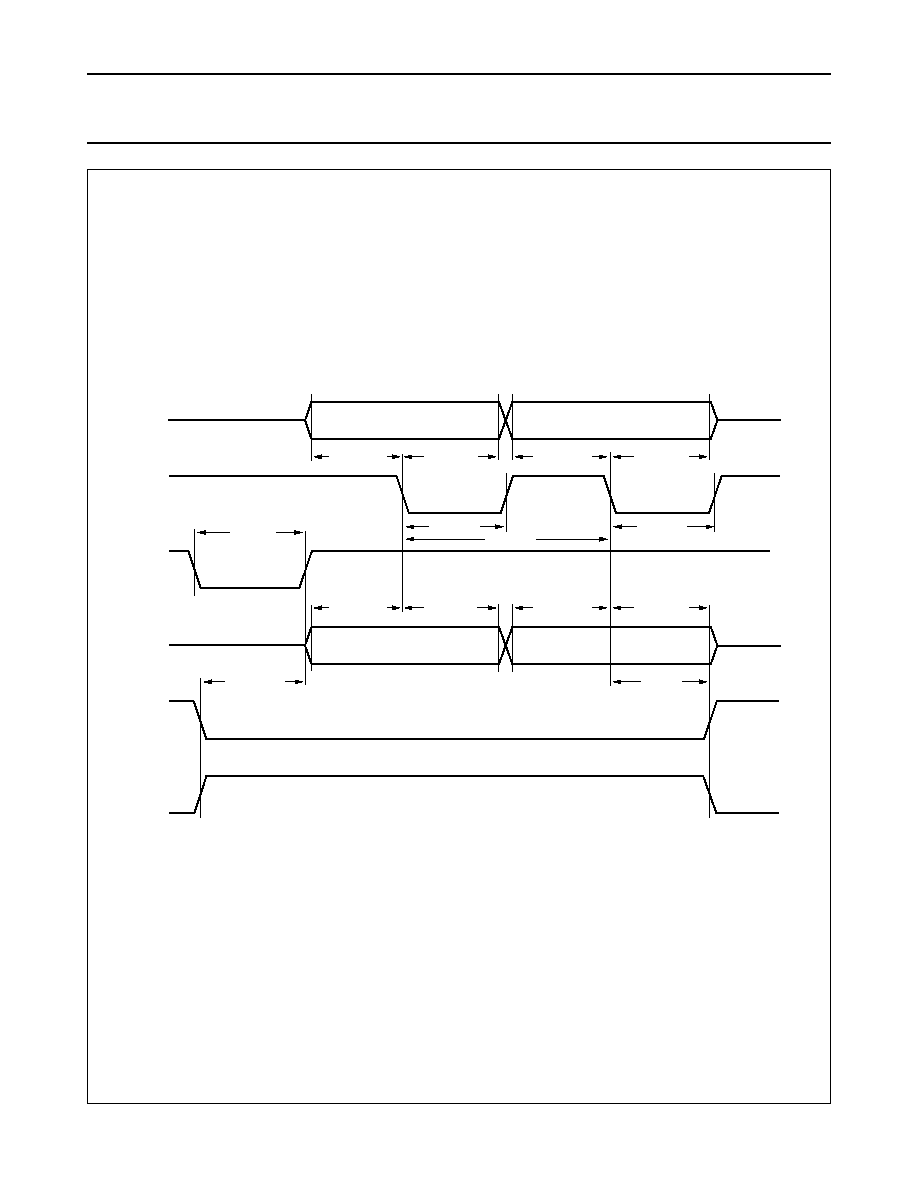
1997 Jan 29
28
Philips Semiconductors
Objective specification
Integrated MPEG2 AVG decoder
SAA7201
Fig.22 SAA7208 mode; burst write timing.
handbook, full pagewidth
MGD920
DATA
(15 to 0)
ADDRESS
(8 to 0)
CS
SYSRD
RDY
DATA
DATA
ALE
tW(ALE)
tsu(D-SDR)
th(D-SDR)
tsu(D-SDR)
th(D-SDR)
tW(SDR)
tW(SDR)
trel(SDR)
ADDRESS
ADDRESS
th(CS)
th(CS-ALE)
tsu(A-SDR)
th(A-SDR)
tsu(A-SDR)
th(A-SDR)
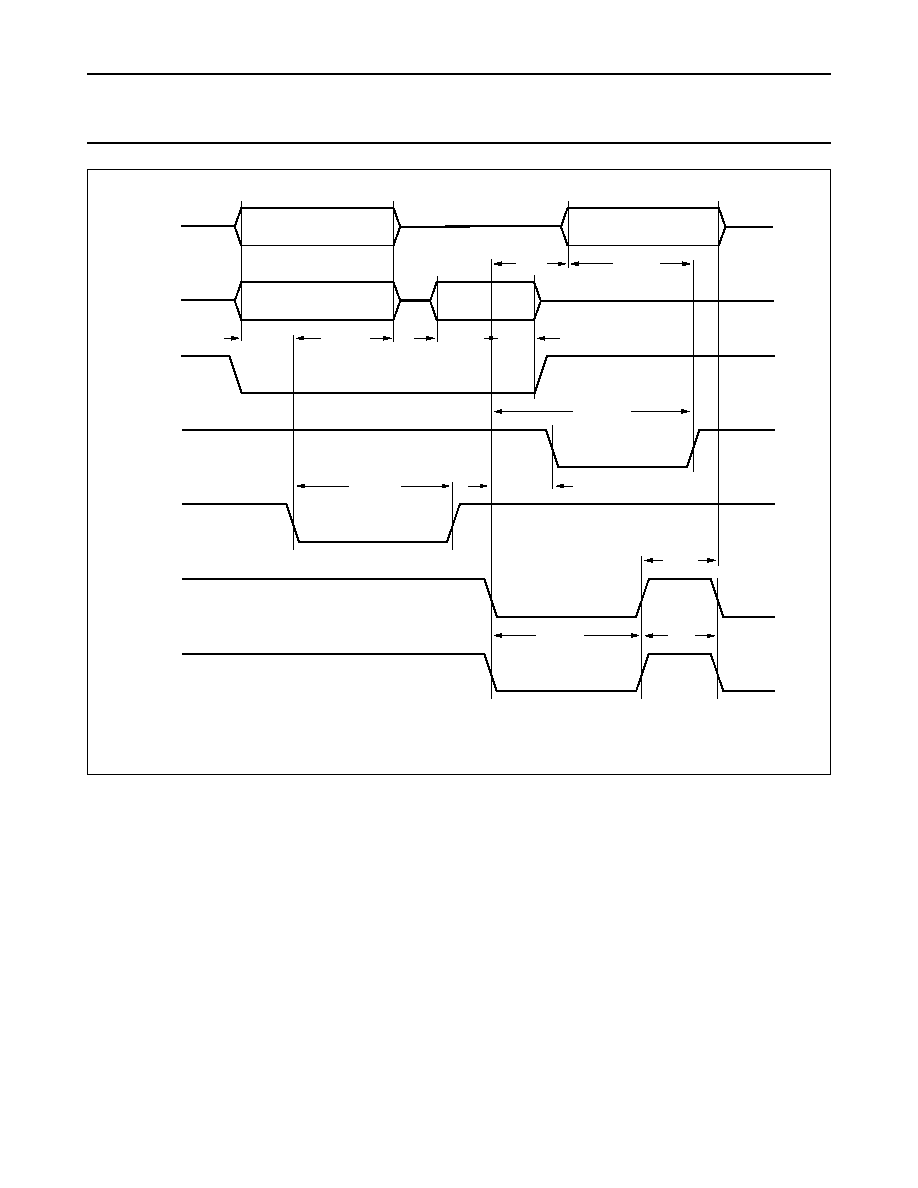
1997 Jan 29
29
Philips Semiconductors
Objective specification
Integrated MPEG2 AVG decoder
SAA7201
REFERENCES
1.
MPEG ISO/IEC 11172-1 International standard; MPEG-1 systems.
2.
MPEG ISO/IEC 13818-1 International standard; MPEG-2 systems.
3.
MPEG ISO/IEC 11172-2 International standard; MPEG-1 Video.
4.
MPEG ISO/IEC 13818-2 International standard; MPEG-2 Video.
5.
MPEG ISO/IEC 11172-3 International standard; MPEG-1 Audio.
6.
MPEG ISO/IEC 13818-3 International standard; MPEG-2 Audio.
7.
DVB subtitling system; working draft 2.0; TM 1398 rev 2.
Fig.23 Intel read/write timing multiplexed.
handbook, full pagewidth
ADDRESS
ADDRESS
DATA
DATA
MGD341
AD(read)
AD(write)
CS
RD
RDY
ALE
tW(ACK)
trel(D)
trel(ACK)
tW(A-CS)
tsu(D-R)
tAR
th(D)
tsu(D-W)
th(A-CS)
tsu(A-S)
trel
tW(RW)
WR

1997 Jan 29
30
Philips Semiconductors
Objective specification
Integrated MPEG2 AVG decoder
SAA7201
APPLICATION INFORMATION
Fig.24 Application diagram.
handbook, full pagewidth
SAA7208
(DEMUX/MIPS)
4 Mbit
EPROM
4 Mbit
DRAM
SAA7201
SAA7183
(EURO-DENC)
16 Mbit
SDRAM
AUDIO
DA
8
+
3
12
address data
control
8
16
16
INT
H,V valid
YUV
CVBS
MGD342
RGB
Y/C
L
R
strobe
27.0
MHz
27 MHz
I
2
C-bus
I
2
C-bus
H, V, FP
TTX/TTXRQ
high
speed
data

1997 Jan 29
31
Philips Semiconductors
Objective specification
Integrated MPEG2 AVG decoder
SAA7201
APPENDIX
Syntax of pixel-data-sub-block
data type
pixel-code-string of N-coded words
end of string
2 bit/pixel
01
1 pixel in colour 1
10
1 pixel in colour 2
0001 0000
11
1 pixel in colour 3
00 00 00
00 01
1 pixel in colour 0
00 00 01
2 pixels in colour 0
00 1L LL CC
L pixels (3 to 10) in colour C
00 00 10 LL LL CC
L pixels (12 to 27) in colour C
00 00 11 LL LL LL LL CC
L pixels (29 to 284) in colour C
4 bit/pixel
0001
1 pixel in colour 1
0001 0001
1111
1 pixel in colour 15
0000 0000
0000 1100
1 pixel in colour 0
0000 1101
2 pixels in colour 0
0000 0LLL (L>0)
L pixels (3 to 9) in colour 0
0000 10LL CCCC
L pixels (4 to 7) in colour C
0000 1110 LLLL CCCC
L pixels (9 to 24) in colour C
0000 1111 LLLL LL11 CCCC
L pixels (25 to 280) in colour C
8 bit/pixel
00000001
1 pixel in colour 1
00000000-- --00000000
0001 0010
11111111
1 pixel in colour 255
00000000 0LLLLLLL
L pixels (1 to 127) in colour 0
00000000 1LLLLLLL CCCCCCCC
L pixels (3 to 127) in colour C
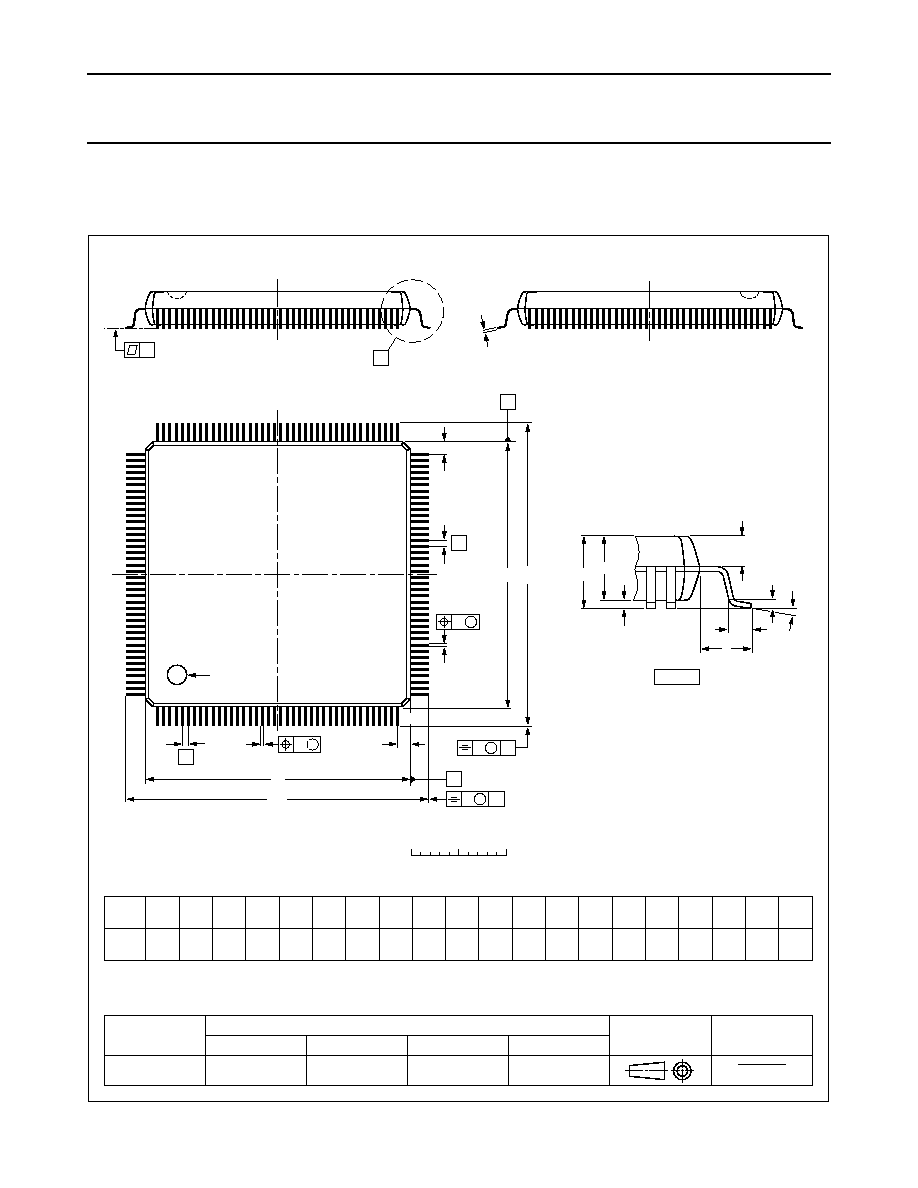
1997 Jan 29
32
Philips Semiconductors
Objective specification
Integrated MPEG2 AVG decoder
SAA7201
PACKAGE OUTLINE
UNIT
A
1
A
2
A
3
b
p
c
E
(1)
(1)
(1)
e
H
E
L
L
p
Q
Z
y
w
v
REFERENCES
OUTLINE
VERSION
EUROPEAN
PROJECTION
ISSUE DATE
IEC
JEDEC
EIAJ
mm
0.40
0.25
3.70
3.15
0.25
0.40
0.25
0.23
0.13
28.1
27.9
0.65
0.3
1.95
32.2
31.6
1.70
1.55
1.5
1.1
8
0
o
o
0.15
0.1
DIMENSIONS (mm are the original dimensions)
Note
1. Plastic or metal protrusions of 0.25 mm maximum per side are not included.
1.1
0.7
SOT322-1
MO112DD1
93-08-25
95-02-04
D
(1)
28.1
27.9
H
D
32.2
31.6
E
Z
1.5
1.1
D
pin 1 index
b
p
e
E
A
1
A
L
p
Q
detail X
L
(A )
3
B
40
c
D
H
b
p
E
H
A
2
v
M
B
D
Z D
A
Z E
e
v
M
A
X
1
160
121
120
81
80
41
y
w
M
w
M
0
5
10 mm
scale
SOT322-1
160 leads (lead length 1.95 mm); body 28 x 28 x 3.4 mm; high stand-off height
QFP160: plastic quad flat package;
A
max.
3.95

1997 Jan 29
33
Philips Semiconductors
Objective specification
Integrated MPEG2 AVG decoder
SAA7201
SOLDERING
Introduction
There is no soldering method that is ideal for all IC
packages. Wave soldering is often preferred when
through-hole and surface mounted components are mixed
on one printed-circuit board. However, wave soldering is
not always suitable for surface mounted ICs, or for
printed-circuits with high population densities. In these
situations reflow soldering is often used.
This text gives a very brief insight to a complex technology.
A more in-depth account of soldering ICs can be found in
our
"IC Package Databook" (order code 9398 652 90011).
Reflow soldering
Reflow soldering techniques are suitable for all QFP
packages.
The choice of heating method may be influenced by larger
plastic QFP packages (44 leads, or more). If infrared or
vapour phase heating is used and the large packages are
not absolutely dry (less than 0.1% moisture content by
weight), vaporization of the small amount of moisture in
them can cause cracking of the plastic body. For more
information, refer to the Drypack chapter in our
"Quality
Reference Handbook" (order code 9397 750 00192).
Reflow soldering requires solder paste (a suspension of
fine solder particles, flux and binding agent) to be applied
to the printed-circuit board by screen printing, stencilling or
pressure-syringe dispensing before package placement.
Several techniques exist for reflowing; for example,
thermal conduction by heated belt. Dwell times vary
between 50 and 300 seconds depending on heating
method. Typical reflow temperatures range from
215 to 250
∞
C.
Preheating is necessary to dry the paste and evaporate
the binding agent. Preheating duration: 45 minutes at
45
∞
C.
Wave soldering
Wave soldering is not recommended for QFP packages.
This is because of the likelihood of solder bridging due to
closely-spaced leads and the possibility of incomplete
solder penetration in multi-lead devices.
If wave soldering cannot be avoided, the following
conditions must be observed:
∑
A double-wave (a turbulent wave with high upward
pressure followed by a smooth laminar wave)
soldering technique should be used.
∑
The footprint must be at an angle of 45
∞
to the board
direction and must incorporate solder thieves
downstream and at the side corners.
Even with these conditions, do not consider wave
soldering the following packages: QFP52 (SOT379-1),
QFP100 (SOT317-1), QFP100 (SOT317-2),
QFP100 (SOT382-1) or QFP160 (SOT322-1).
During placement and before soldering, the package must
be fixed with a droplet of adhesive. The adhesive can be
applied by screen printing, pin transfer or syringe
dispensing. The package can be soldered after the
adhesive is cured.
Maximum permissible solder temperature is 260
∞
C, and
maximum duration of package immersion in solder is
10 seconds, if cooled to less than 150
∞
C within
6 seconds. Typical dwell time is 4 seconds at 250
∞
C.
A mildly-activated flux will eliminate the need for removal
of corrosive residues in most applications.
Repairing soldered joints
Fix the component by first soldering two diagonally-
opposite end leads. Use only a low voltage soldering iron
(less than 24 V) applied to the flat part of the lead. Contact
time must be limited to 10 seconds at up to 300
∞
C. When
using a dedicated tool, all other leads can be soldered in
one operation within 2 to 5 seconds between
270 and 320
∞
C.

1997 Jan 29
34
Philips Semiconductors
Objective specification
Integrated MPEG2 AVG decoder
SAA7201
DEFINITIONS
LIFE SUPPORT APPLICATIONS
These products are not designed for use in life support appliances, devices, or systems where malfunction of these
products can reasonably be expected to result in personal injury. Philips customers using or selling these products for
use in such applications do so at their own risk and agree to fully indemnify Philips for any damages resulting from such
improper use or sale.
Data sheet status
Objective specification
This data sheet contains target or goal specifications for product development.
Preliminary specification
This data sheet contains preliminary data; supplementary data may be published later.
Product specification
This data sheet contains final product specifications.
Limiting values
Limiting values given are in accordance with the Absolute Maximum Rating System (IEC 134). Stress above one or
more of the limiting values may cause permanent damage to the device. These are stress ratings only and operation
of the device at these or at any other conditions above those given in the Characteristics sections of the specification
is not implied. Exposure to limiting values for extended periods may affect device reliability.
Application information
Where application information is given, it is advisory and does not form part of the specification.

1997 Jan 29
35
Philips Semiconductors
Objective specification
Integrated MPEG2 AVG decoder
SAA7201
NOTES

Internet: http://www.semiconductors.philips.com
Philips Semiconductors ≠ a worldwide company
© Philips Electronics N.V. 1997
SCA53
All rights are reserved. Reproduction in whole or in part is prohibited without the prior written consent of the copyright owner.
The information presented in this document does not form part of any quotation or contract, is believed to be accurate and reliable and may be changed
without notice. No liability will be accepted by the publisher for any consequence of its use. Publication thereof does not convey nor imply any license
under patent- or other industrial or intellectual property rights.
Netherlands: Postbus 90050, 5600 PB EINDHOVEN, Bldg. VB,
Tel. +31 40 27 82785, Fax. +31 40 27 88399
New Zealand: 2 Wagener Place, C.P.O. Box 1041, AUCKLAND,
Tel. +64 9 849 4160, Fax. +64 9 849 7811
Norway: Box 1, Manglerud 0612, OSLO,
Tel. +47 22 74 8000, Fax. +47 22 74 8341
Philippines: Philips Semiconductors Philippines Inc.,
106 Valero St. Salcedo Village, P.O. Box 2108 MCC, MAKATI,
Metro MANILA, Tel. +63 2 816 6380, Fax. +63 2 817 3474
Poland: Ul. Lukiska 10, PL 04-123 WARSZAWA,
Tel. +48 22 612 2831, Fax. +48 22 612 2327
Portugal: see Spain
Romania: see Italy
Russia: Philips Russia, Ul. Usatcheva 35A, 119048 MOSCOW,
Tel. +7 095 755 6918, Fax. +7 095 755 6919
Singapore: Lorong 1, Toa Payoh, SINGAPORE 1231,
Tel. +65 350 2538, Fax. +65 251 6500
Slovakia: see Austria
Slovenia: see Italy
South Africa: S.A. PHILIPS Pty Ltd., 195-215 Main Road Martindale,
2092 JOHANNESBURG, P.O. Box 7430 Johannesburg 2000,
Tel. +27 11 470 5911, Fax. +27 11 470 5494
South America: Rua do Rocio 220, 5th floor, Suite 51,
04552-903 S„o Paulo, S√O PAULO - SP, Brazil,
Tel. +55 11 821 2333, Fax. +55 11 829 1849
Spain: Balmes 22, 08007 BARCELONA,
Tel. +34 3 301 6312, Fax. +34 3 301 4107
Sweden: Kottbygatan 7, Akalla, S-16485 STOCKHOLM,
Tel. +46 8 632 2000, Fax. +46 8 632 2745
Switzerland: Allmendstrasse 140, CH-8027 ZÐRICH,
Tel. +41 1 488 2686, Fax. +41 1 481 7730
Taiwan: Philips Semiconductors, 6F, No. 96, Chien Kuo N. Rd., Sec. 1,
TAIPEI, Taiwan Tel. +886 2 2134 2870, Fax. +886 2 2134 2874
Thailand: PHILIPS ELECTRONICS (THAILAND) Ltd.,
209/2 Sanpavuth-Bangna Road Prakanong, BANGKOK 10260,
Tel. +66 2 745 4090, Fax. +66 2 398 0793
Turkey: Talatpasa Cad. No. 5, 80640 GÐLTEPE/ISTANBUL,
Tel. +90 212 279 2770, Fax. +90 212 282 6707
Ukraine: PHILIPS UKRAINE, 4 Patrice Lumumba str., Building B, Floor 7,
252042 KIEV, Tel. +380 44 264 2776, Fax. +380 44 268 0461
United Kingdom: Philips Semiconductors Ltd., 276 Bath Road, Hayes,
MIDDLESEX UB3 5BX, Tel. +44 181 730 5000, Fax. +44 181 754 8421
United States: 811 East Arques Avenue, SUNNYVALE, CA 94088-3409,
Tel. +1 800 234 7381
Uruguay: see South America
Vietnam: see Singapore
Yugoslavia: PHILIPS, Trg N. Pasica 5/v, 11000 BEOGRAD,
Tel. +381 11 625 344, Fax.+381 11 635 777
For all other countries apply to: Philips Semiconductors, Marketing & Sales Communications,
Building BE-p, P.O. Box 218, 5600 MD EINDHOVEN, The Netherlands, Fax. +31 40 27 24825
Argentina: see South America
Australia: 34 Waterloo Road, NORTH RYDE, NSW 2113,
Tel. +61 2 9805 4455, Fax. +61 2 9805 4466
Austria: Computerstr. 6, A-1101 WIEN, P.O. Box 213,
Tel. +43 1 60 101, Fax. +43 1 60 101 1210
Belarus: Hotel Minsk Business Center, Bld. 3, r. 1211, Volodarski Str. 6,
220050 MINSK, Tel. +375 172 200 733, Fax. +375 172 200 773
Belgium: see The Netherlands
Brazil: see South America
Bulgaria: Philips Bulgaria Ltd., Energoproject, 15th floor,
51 James Bourchier Blvd., 1407 SOFIA,
Tel. +359 2 689 211, Fax. +359 2 689 102
Canada: PHILIPS SEMICONDUCTORS/COMPONENTS,
Tel. +1 800 234 7381
China/Hong Kong: 501 Hong Kong Industrial Technology Centre,
72 Tat Chee Avenue, Kowloon Tong, HONG KONG,
Tel. +852 2319 7888, Fax. +852 2319 7700
Colombia: see South America
Czech Republic: see Austria
Denmark: Prags Boulevard 80, PB 1919, DK-2300 COPENHAGEN S,
Tel. +45 32 88 2636, Fax. +45 31 57 1949
Finland: Sinikalliontie 3, FIN-02630 ESPOO,
Tel. +358 9 615800, Fax. +358 9 61580/xxx
France: 4 Rue du Port-aux-Vins, BP317, 92156 SURESNES Cedex,
Tel. +33 1 40 99 6161, Fax. +33 1 40 99 6427
Germany: Hammerbrookstraþe 69, D-20097 HAMBURG,
Tel. +49 40 23 53 60, Fax. +49 40 23 536 300
Greece: No. 15, 25th March Street, GR 17778 TAVROS/ATHENS,
Tel. +30 1 4894 339/239, Fax. +30 1 4814 240
Hungary: see Austria
India: Philips INDIA Ltd, Shivsagar Estate, A Block, Dr. Annie Besant Rd.
Worli, MUMBAI 400 018, Tel. +91 22 4938 541, Fax. +91 22 4938 722
Indonesia: see Singapore
Ireland: Newstead, Clonskeagh, DUBLIN 14,
Tel. +353 1 7640 000, Fax. +353 1 7640 200
Israel: RAPAC Electronics, 7 Kehilat Saloniki St, TEL AVIV 61180,
Tel. +972 3 645 0444, Fax. +972 3 649 1007
Italy: PHILIPS SEMICONDUCTORS, Piazza IV Novembre 3,
20124 MILANO, Tel. +39 2 6752 2531, Fax. +39 2 6752 2557
Japan: Philips Bldg 13-37, Kohnan 2-chome, Minato-ku, TOKYO 108,
Tel. +81 3 3740 5130, Fax. +81 3 3740 5077
Korea: Philips House, 260-199 Itaewon-dong, Yongsan-ku, SEOUL,
Tel. +82 2 709 1412, Fax. +82 2 709 1415
Malaysia: No. 76 Jalan Universiti, 46200 PETALING JAYA, SELANGOR,
Tel. +60 3 750 5214, Fax. +60 3 757 4880
Mexico: 5900 Gateway East, Suite 200, EL PASO, TEXAS 79905,
Tel. +9-5 800 234 7381
Middle East: see Italy
Printed in The Netherlands
547047/1200/01/pp36
Date of release: 1997 Jan 29
Document order number:
9397 750 00989



































